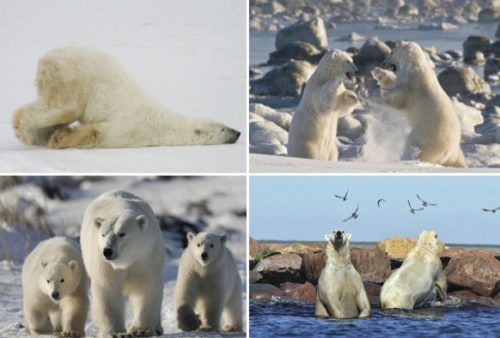“If I Couldn’t Tell These Stories, I Would Die”: Lincoln and Laughter
Imagine the unknown Lincoln. Picture the frontier lawyer who stepped onto the national stage — unkempt, gawky, blunt, speaking with a prairie twang in a high voice. And homely. Lord, he was homely.
Lincoln’s contemporaries, seeing him for the first time, might have noticed the same two things that struck Lew Wallace when he first saw Lincoln.
Later in life, Wallace was a best-selling author, a celebrated Union general, and a territorial governor. But in 1851, he was just another attorney who rode the judicial circuit with other lawyers. One evening, just after sundown, he rode into Danville, Illinois, and entered the local tavern. He found it crowded with people attending court business. As he edged his way into the crowd, he heard occasional bursts of laughter over the noise of the bar. Working his way toward the sound, he found that two teams of lawyers from Indiana and Illinois were have a joke-telling contest.
He took particular note of one of the contestants representing Illinois.
He arrested my attention early, partly by his stories, partly by his appearance. Out of the mist of years he comes to me now exactly as he appeared then. His hair was thick, coarse, and defiant; it stood out in every direction. His features were massive, nose long, eyebrows protrusive, mouth large, cheeks hollow, eyes gray and always responsive to the humor. He smiled all the time, but never once did he laugh outright. His hands were large, his arms slender and disproportionately long. His legs were a wonder, particularly when he was in narration; he kept crossing and uncrossing them; sometime it actually seemed he was trying to tie them into a bow-knot. His dress was more than plain; no part of it fit him… Altogether I thought him the gauntest, quaintest, and most positively ugly man.
What was even more memorable to Wallace was Lincoln’s ability to hold a room’s attention — and his apparently bottomless fund of jokes.
About midnight, his competitors were disposed to give in; either their stores were exhausted, or they were tacitly conceding him the crown. From answering them story for story, he gave two or three to their one. At last he took the floor and held it… Such was Abraham Lincoln. And to be perfectly candid, had one stood at my elbow that night in the old tavern and whispered: “Look at him closely. He will one day be president and the savior of his country,” I had laughed at the idea but a little less heartily than I laughed at the man. Afterwards I came to know him better, and then I did not laugh.
Humor was an essential part of Lincoln, and a critical element in his success. As a Congressional candidate, he used it to fire up crowds and put down hecklers. Running for the senate, his humor enabled him to score points off the well known and skilled politician, Stephen Douglas. When, for example, Douglas told a debate crowd that Lincoln was unqualified and unskilled, he added that Lincoln had once run a general store, selling cigars and whiskey. He added, “Mr. Lincoln was a very good bartender.” Lincoln retorted, “Many a time have I stood on one side of the counter… and sold Mr. Douglas whiskey on the other side.”
When Douglas accused Lincoln of being “two faced,” Lincoln shot back, “If I really had two faces, do you think I’d hide behind this one?”
Humor also proved valuable to Lincoln as president. As Robert M. Yoder noted in a 1954 Post article,
If a time-wasting friend lingered too long, Lincoln could disengage himself by telling a story which ended the conversation. He answered questions with stories; he avoided answering by telling stories. If the conversation headed in directions he didn’t like, he could change the subject with a story.
And, as we know now, humor helped Lincoln maintain his sanity.
“If I couldn’t tell these stories,” Lincoln once told a congressman — and gravely—”I would die.” Humor was of tremendous importance to this sensitive and sorrowful man; almost a sort of oxygen for the soul. It offended a good many citizens that Lincoln could joke in times so tragic, but those close to Lincoln understood the emotional process involved. It was jesting-that-I-may-not-weep.
Yoder offered several examples of Lincoln’s jokes. Some are familiar, but the number of unfamiliar stories suggests that Lincoln knew far more jokes than have been recorded.
When a courier appeared at the War Office to announce a major Union victory, the officers were surprised that Lincoln showed no excitement. Lincoln dismissed the courier and cheerfully told the men in the room,
Pay no attention to him… He’s the biggest liar in Washington. He reminds me of an old fisherman I used to know who got such a reputation for stretching the truth that he bought a pair of scales and insisted on weighing every fish in the presence of witnesses. One day a baby was born next door and the doctor borrowed the fisherman’s scales. The baby weighed forty-seven pounds.
Once when he found all his advisers solidly against him, he told this story:
A drunk wandered into a revival meeting and, after mumbling, “Amen,” a few times, fell asleep. As the meeting closed, the preacher cried, “Who are on the Lord’s side?” The congregation stood as one — all except the slumbering drunk. That shout didn’t wake him, but the next one did. “Who are on the devil’s side?” the revivalist cried. That roused the sleeper. Seeing the preacher standing, the drunk rose too. “I didn’t exactly understand the question,” he said warmly, “but I’m with you, parson, to the end.” He looked around at the silent crowd, all seated. “But it seems to me,” said the drunk, “that we’re in a hopeless minority.”
Lincoln’s easy use of humor changed America’s taste in politicians. Previously, Americans had preferred solemn, humorless men with the gravity of Old Testament prophets. We now expect our legislators and presidents to occasionally tell, and laugh at, jokes. We believe a sense of humor reflects a sense of reason and proportion, and an ability to perceive the outrageous.
In many regards, Lincoln was a man ahead of his times. He saw, sooner than most of his contemporaries, what we all recognize: laughter is necessary for keeping our sanity.
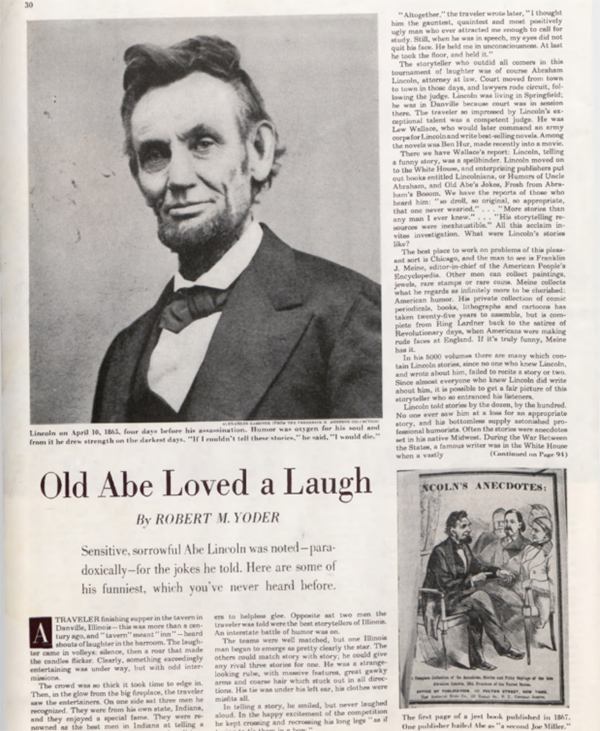
Featured image: Library of Congress
Easter Madness Takes Manhattan
Every Easter, New York natives and tourists gather on Fifth Avenue for the annual Easter Parade. The parade is less of an organized march and more of a stroll to see and be seen. Bonnets feature everything from bunny ears to bee hives. Men sport straw boaters and bedazzled top hats, and pets get in on the action, too (reluctantly, by the looks of it).
The history of the parade dates back to the mid-1800s, when churchgoers would take to Fifth Avenue like a Paris fashion show runway after morning services. Locals would gather along the avenue to admire their latest attire. By the middle of the 20th century, more than million people would show up.
In the April, 9, 1955, issue of The Saturday Evening Post, writer Rufus Jarman explored the parade’s fanciful behavior in “Manhattan’s Easter Madness.” Jarman reported that the police would try to maintain some semblance or order, including the ouster of “poseurs in weird raiment and women wearing ridiculously exhibitionistic hats.”
But the mid-century paraders would not be denied. One woman’s hat featured “a model of the Last Supper, the Crucifixion, a troop of Roman soldiery and a live parakeet.” There were kids in space suits, dogs with pipes, and a man in a silver sombrero hawking trips to Mexico.
Jarman proclaimed the whole affair to be completely out-of-hand. The proof? “These things horrified even New Yorkers.”
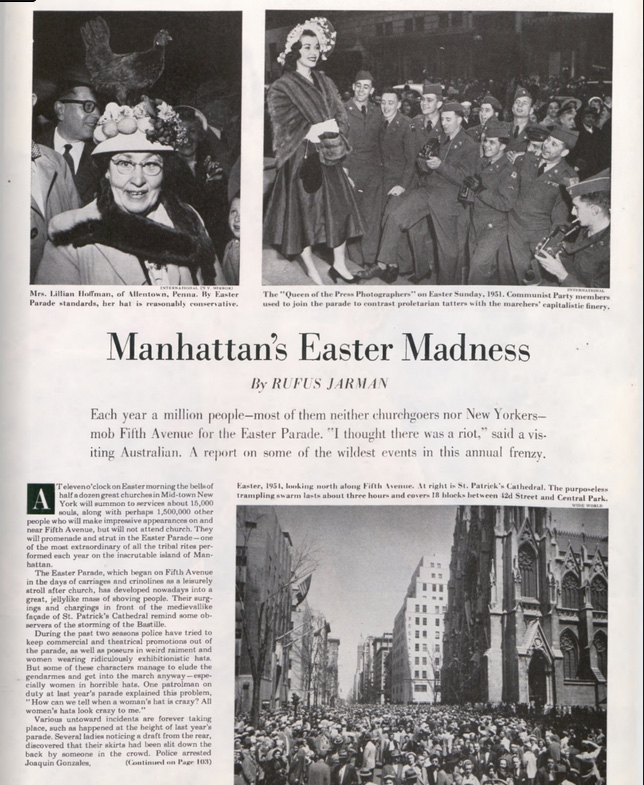
Featured image: April 7, 1906 Easter cover by J.C. Leyendecker (©SEPS)
Edgar Rice Burroughs on How to Become a Great Writer
This article was originally published in The Saturday Evening Post on July 29, 1939.
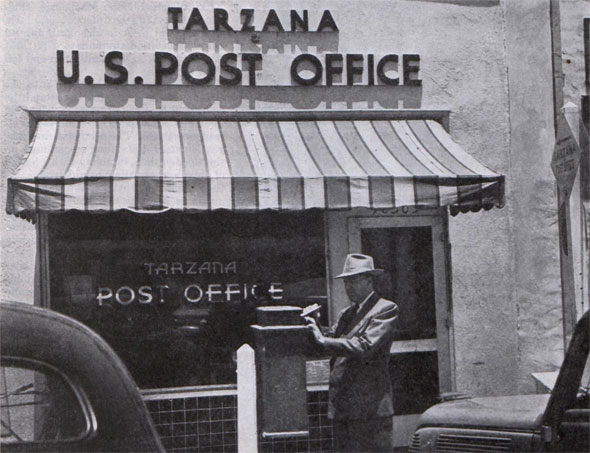
Is any other town in America named for a character in fiction?
Everybody sooner or later turns out to be a writer. Get deep enough into anybody’s confidence, and you find that he has manuscripts. Psychoanalysts build a false science on the theory that millions of people are maladjusted lovers; a better knowledge of the world would teach that they are maladjusted writers.
David Binney Putnam launched himself on a serious literary career by wearing overalls, growing a beard and setting out to get the life stories of derelicts; the first derelict he met was a writer who took out a notebook and insisted on having young Putnam’s life story.
Harold Ross, editor of The New Yorker, finding himself sick of New York City’s 7,300,000 writers, tried to hunt a spot where there were no writers. He and Harpo Marx drove a car far into the Rockies. En route Harpo turned out to be a secret writer. The car broke down. The editor followed a trail leading to a cabin in a lonely mountain valley. In the cabin he found a writer writing a novel.
All this shows that, as Ed Howe put it, the people are smart. They are on the right trail. Writing is the shortest cut to affluence except inheriting big money. Today is the harvest time for writers, and tomorrow’s prospect is still better. A sure-hit writer can get $5,000 a week and upwards in Hollywood. A good radio-script man or woman is worth four figures a week. Magazine editors and book publishers go out in posses after any promising writer. Writing is the royal road to statesmanship; there is an enormous demand on the part of public men in Washington and elsewhere for artists in the oration-writing department of belles-lettres. Television holds a promise of becoming a writers’ paradise; if it is a success it will require legions of writers to feed the television studios with scripts.
The paradox of the literary situation is that, while everybody is a writer, there is a shortage of writers for the thousand-a-week spots and the five-thousand-a-week spots. According to Pandro Berman, head of the RKO picture studio, Hollywood can’t get one tenth of the good writers it needs. His solution of the problem is for the universities to stop concentrating on the second-rate professions, which are already overcrowded, and to devote themselves to turning out big-money master writers, who are needed by the thousands. Law, medicine, engineering and the sciences have proved themselves to be excellent stopgaps and steppingstones for writers, but the demand of the time is for direct literary training which will enable young men and women to assume the thousand-a-week burdens immediately on graduation.
The main difficulty with Berman’s suggestion is that of organizing the courses. Nobody seems to have worked out a satisfactory method of training writers to write. Colleges are good on punctuation marks, but not on what to put between them. Famous writers seem to have left few hints that are useful to beginners. Ring Lardner said it was a matter of selecting pencils of the right colors. Anthony Trollope said it was a matter of attaching the writer’s pants to the chair with beeswax. Goethe attributed his output to a chair in which it was impossible to get into a restful position. In the vast literature about Dr. Samuel Johnson, only one practical rule of writing is to be found, and Doctor Johnson had that from an old schoolmaster; the rule being that, if you think any sentence you write is particularly good, strike it out. Dickens picked up his technique by accident. As a Parliamentary shorthand reporter during the decadence of parliamentary oratory, he learned the comic effect of presenting trivialities in ornate and sounding prose.
Tests of Greatness
The subject has to be simplified before the universities cap turn out prose masters on belt conveyors. A new approach to the problem would be to take the greatest living writer and make a thorough analysis of the factors, which caused his greatness. Because of differences of opinion as to who is the greatest living writer, it is necessary to adopt arbitrary tests to identify him.
These tests are:
- The size of the writer’s public.
- His success in establishing a character in the consciousness of the world.
- The probability of his being read by posterity.
Judged by these tests, Edgar Rice Burroughs is first and the rest nowhere.
No other literary creation of this century has a following like Tarzan. Another character with a worldwide public is Mickey Mouse, but he belongs to a different art. The only other recent works of imagination in this class are Charlie McCarthy and The Lone Ranger, but their vogue is confined to the English-speaking peoples and they are still novelties rather than assured immortals.
Twenty-five million copies of the Tarzan books have been sold. Taman has established his durability; the first book on the ape boy came out a quarter of a century ago, and he is today more popular than ever. A writer’s foreign following has been described as a contemporary posterity; Tarzan books have been translated into fifty-six languages and dialects. Hundreds of baseball players, football players, wrestlers, fighters and other athletes are nicknamed Tarzan. Extra-large schoolboys are called Tarzan in admiration, and undersized ones are called Tarzan in derision. Sherlock Holmes, Peter Pan, Pollyanna and Babbitt are perhaps the only literary creations of the last fifty years whose names are rooted in the English language as strongly as Tarzan; and Tarzan is a household word on every continent and on the larger islands from Iceland to Java.
Tarzan is a pillar of the American fiscal system. Through his author, his motion-picture company, his cartoon-strip syndicate, his radio sponsors and his various other concessionaires, the African ape boy contributes enough in taxes to pay the salaries of most of the United States senators.
What Makes Him Click
Burroughs is clearly the man to tell the 130,000,000 American writers how to write. His life story ought to be the supreme textbook. The main rules for literary training that can be gathered from the experiences of Burroughs are:
- Be a disappointed man.
- Achieve no success at anything you touch.
- Lead an unbearably drab and uninteresting life.
- Hate civilization.
- Learn no grammar.
- Read little.
- Write nothing.
- Have an ordinary mind and commonplace tastes, approximating those of the great reading public.
- Avoid subjects that you know about.
Burroughs had been an ill-paid employee and an unsuccessful small businessman for fifteen years before he wrote a word of fiction. The great difficulty in basing a college training on his rules is that of compressing into four years all the dullness, wretchedness and futility which it took Burroughs fifteen years to assimilate.
Burroughs started at twenty as a cattle drover and then became an employee on a gold dredge in Oregon. For a time he was a railroad policeman in Salt Lake City. He put in stretches as an accountant, as a clerk and as a peddler. His most important position was that of head of the stenographic department of Sears-Roebuck, in Chicago. A docile employee, he was never fired. An inveterate reader of help-wanted ads, he was constantly obtaining new positions not quite equal to his old ones. Added to that, he was always ready to join his own pennilessness to the pennilessness of some other man, and to found a partnership on any naïve dream of avarice.
King of the Pot-and-Pan Trade
Combining their resources of no capital, no experience and no contacts, Burroughs and a partner founded an advertising agency, which failed. Having no experience with salesmanship beyond that of being repulsed by housewives when he tried to sell sets of Stoddard’s Lectures, Burroughs wrote a correspondence course in salesmanship. After studying by correspondence for a few weeks, his students were to be graduated into fieldwork. Small stocks of aluminum pots and pans were sent to them with instructions to sell them from door to door and remit the money to the home office.
Burroughs and his partner thought there were millions in it. They regarded themselves as aluminum kings about to corner the pot-and-pan trade with the help of peddlers who would pay tuition fees for the privilege of peddling. But the students all quit when they got to the fieldwork stage. Some failed to send back either the money or the pots and pans.
The Burroughs family had been rich when Edgar was a boy, but had lost its money. His allowance at prep-school had been $150 a month. During his entire business career he never earned as much as his prep-school allowance. Twice he was compelled to pawn his family heirlooms in order to buy food for his wife and children. His failure as a businessman was so complete that he was reduced to earning a living by writing hints on how to become a successful businessman.
The businessman’s bible three decades ago was System, the Magazine of Efficiency. It was a pioneer in introducing charts and graphs. Many businessmen worshiped charts and graphs as religious symbols. It was their belief that, if they stared long enough at these mystic curves and angles, red ink would turn into black.
A new department was introduced by the magazine. On payment of fifty dollars a year, a businessman could write to the magazine as often as he liked, and receive detailed advice on his business problems. Burroughs was hired to give the detailed advice. There was also a detailed-advice department for bankers, which was handled by a youth of twenty-one years. Burroughs sat at his desk from morning until night, writing counsel to merchant princes and captains. He used words that rumbled with portentous business wisdom, but were too vague to enable any industrial baron to net on them. Burroughs had a conscience, and it was always his fear that, if his advice ever became understandable, it would land his clients in the bankruptcy courts. With his letters he would enclose some of the awe-inspiring hieroglyphics now known as “barometrics.”
Burroughs’ advice never brought a complaint, and he may have been as good as anybody else in this field. Nothing is definitely known on the subject today except that the more the charts and graphs flourish, the faster business decays.
Burroughs’ first contact with literature came in 1911 through his connection with Alcola, a cure for alcoholism. Alcola cured alcoholism all right, but the Federal Pure Food and Drug people took the position that there were worse things than alcoholism, and forbade the sale of Alcola.
One of Burroughs’ duties in the Alcola firm was that of putting advertisements in the pulp fiction magazines. He bought the magazines in order to make sure that his ads were printed. He detested fiction, but when he looked at the ads some of the reading matter entered his field of vision. His reaction was approximately that of Dean Swift, who, under similar circumstances, exclaimed, “No man alive ever writ such damned stuff.”
His next thought was that, if this was literature, any man could be a man of letters if he would abandon his mind to it. He wrote a novel. Thomas Newell Metcalf, editor of the All-Story Magazine, accepted it and sent Burroughs a check for $400. It was published as a serial in All-Story in 1912, under the title of Under the Moon of Mars.
Metcalf wanted to make a Sir Walter Scott out of Burroughs. He induced him to spend months of research on the Wars of the Roses. The result was a novel entitled The Outlaw of Torn. Metcalf rejected it.
Burroughs saw the folly of research. He had located his first novel on Mars because nobody knew the local color of that planet or the psychology of the Martians, and nobody could check up on him. A similar motive influenced him partly in writing his first Tarzan book, Tarzan of the Apes. He created a new race of apes, bigger than gorillas, and placed them in an unknown part of Africa. He knew that nobody could trip him up on the psychology, customs and language of his own private anthropoids.
For African local color he read Stanley’s In Darkest Africa. He got his flora all right, but he made a blunder in his fauna. One of his important characters was Sabor, the tiger. There are no tigers in Africa. Letters from readers were printed in All-Story on this point. A man in Johannesburg confounded the critics, however, by writing that everybody in Africa referred to leopards as tigers. Nevertheless, Burroughs later changed Sabor to a lioness. He got a check for $700 from All-Story for Tarzan of the Apes.
Burroughs had by this time retired from his last business, that of selling a pencil sharpener, and was devoting all his time to writing. His business career had, by its dreary futility, been a genuine literary apprenticeship. During his last few years in commercial pursuits, life had become almost intolerable to him.
He was too poverty-stricken to pay for any of the tired businessman’s relaxations, but he hit upon a free method of making himself feel better. When he went to bed he would lie awake, telling himself stories. His dislike of civilization caused him frequently to pick localities in distant parts of the solar system. Every night he had his one crowded hour of glorious life. Creating noble characters and diabolical monsters, he made them fight in cockpits in the center of the earth or in distant astronomical regions. The duller the day at the office the weirder his nightly adventures. His waking nightmares became long-drawn-out action serials.
The Delirium Road to Success
Psychiatrists consider these reverie addicts as borderline cases. If Burroughs’ family had known of his mental state, they would have called in a medical man, who would have probably insisted on having his teeth out, according to the fashionable method of treating such patients in 1911. Twenty years later, Burroughs would have been advised to save up his money for a few years and go to a psychoanalyst, who would have cured him of an incipient $10,000,000 affliction. A raise of twenty-five dollars a month in 1911, according to Burroughs’ estimate, would have made him happy and caused him to put in nights of sound, refreshing slumber, instead of constructing penny-dreadful deliriums for himself.
Burroughs had given away serials to himself for five years or more before he learned that he could sell them. He had become a master of the slaughterhouse branches of fiction. It is clear from reading the Tarzan and other Burroughs books that he devoted little of his twilight sleep to tea-table and boy-meets-girl imbroglios.
Five years of dark and bloody mysteries gave his pen a high professionalism in pyramiding climaxes and piling up horror; but he was an awkward novice when the structure of his novel required him to introduce scenes of society life or hearts-and-flowers passages. Burroughs is great when Tarzan has a half nelson on a lion or a gorilla, but he has no talent for drawing-room hubble-bubble or boudoir hanky-panky. There is a trace of Homer in him, but not any Noel Coward.
In Tarzan of the Apes the reader can put his finger on the passages where Burroughs is the dream-disciplined artist and on the passages where he is the self-conscious amateur. He wanted to endow his ape-reared infant with a magnificent heredity. He was under the impression that the way to have a glorious moral, mental and physical inheritance was to be a scion of the British aristocracy. So Tarzan’s parents were Lord and Lady Greystoke, the flower of the old nobility. Burroughs created them out of condescending sawdust.
It is obvious that Burroughs in his nightly trances had wasted no time messing around with lords and ladies. The Burroughs noblemen cause the reader to turn instinctively to P. G. Wodehouse for a sympathetic picture of the British aristocracy. But when the real Burroughs gets to work on his wild boy, his colossal anthropoids, his giant carnivora and his cannibals, it is not difficult to see why 3,000,000 copies of Tarzan of the Apes have been sold and why Tarzan is the best-known literary character of the twentieth century.
Burroughs says that his ordinariness explains his success. When he wrote his first novel for All-Story, he used the nom de plume of Normal Bean, meaning common head. By accident the editor changed it to Norman Bean. Burroughs was unwilling to use his own name at the time because he thought it would hurt his standing in the unsuccessful business world. He believes today that his novels are in demand because the things that interest him are bound to interest the ordinary Undoubtedly a certain galloping commonplaceness is one of his assets, but he has others. He did not win his world public solely through mediocrity. There are pages of his books which have the authentic flash and sting of story telling genius.
One brilliant passage is that in which the half-grown Tarzan identifies himself as the being who is reflected in a pool of water. Tarzan had already had reason to suspect that he was not a trueborn ape. Gazing at himself in the waters, he discovers what a poor relation of the higher anthropoids he really is. Burroughs is in a high literary vein when he describes the boy’s chagrin in comparing his parody of a countenance with the pretentious physiognomies of his playmates. Instead of nostrils that spread half across his face, he had a despicable imitation of an organ of smell. He had trifling bits of ivory where competent tusks should have been. Self-pity overwhelmed him when he discovered that his eyes were an insipid gray instead of being big, black and blofldshot. On realizing that he was hairless like a snake, he plastered himself from head to foot with mud.
Tarzan had already suspected that he was not a true ape, because he had discovered in a deserted cabin a number of kindergarten books with pictures of animals. He had begun to fear that he resembled the apes less than he resembled another animal, whose picture was always printed with what appeared to be three little bugs — B, O, and Y. The painful conviction was forced upon him that he was a B-O-Y.
Using these three bugs as a clue, Tarzan works out the secret of all the twenty-six bugs in the alphabet. He learns written English without knowing how to pronounce it. Burroughs’ handling of Tarzan’s self-education is better than the cipher sequences in The Gold Bug or The Dancing Men.
Tarzan’s discovery that he is a member of the human species later lands him in a beautiful ethical dilemma. Having killed an African tribesman, Tarzan is about to help himself. Certain doubts assail him. His bringing up had taught him that eating a member of one’s own species was not done. He has eaten raw gorilla, but the gorilla does not belong to his set. Tarzan now knows himself to be a man, and he recognizes the dead African as a man. On the other hand, Tarzan is hungry, and his political sympathies are all with the apes. It is a pretty case of conscience, and Burroughs does justice to it. In the end Tarzan takes the high ethical stand and never refreshes himself with an African.
Tarzan Gets Slapped
One sequence in Tarzan of the Apes will bear comparison with the much admired passage in Gulliver’s Travels in which the Lilliputians, in an official report on the effects removed from Gulliver’s pockets, suggest that his watch is his god because of the frequency with which he consults it. Tarzan sees Kulonga, son of a savage chief, cook a wild boar and eat it. Tarzan knows fire only as Ara, the lightning. He cannot understand why anybody would spoil raw meat by plunging it into fire. He concludes that Kulonga is a friend of the god of lightning and is sharing the wild boar with him. There is occasionally a touch of poetry in Burroughs, as in describing Tarzan’s grass-woven lasso as “his long arm of many grasses.”
Another source of the author’s strength is his strong grip of character. Not only Tarzan but the apes and animals are highly individualized beings who seldom step out of character. Burroughs edits the Tarzan movies and newspaper strips to see that no liberties are taken with the Tarzan psychology. In one movie scene, for example, Tarzan threw his head back and laughed long and boisterously. “Strike it out,” ordered Burroughs. Tarzan, in spite of his violent activity, is as reserved and contemplative as Hamlet. Nothing could be farther from his personality than brainless uproariousness.
One of the handsome passages in Tarzan of the Apes is the ape-bred boy’s first encounter with white womanhood. Tarzan rescued the heroine, a glamorous but educated American girl, from the clutches of a mate-hunting giant ape. The bronzed and sun-baked Tarzan, accustomed to seeing none but ape women and blacks, was conscious of a sudden prejudice in her favor, in spite of her white body. He wanted her to know that he was favorably disposed toward her. His good will took the form of pawing and nuzzling. She slapped him. Tarzan was astonished. He had assumed that, when a member of a species showed a nice spirit toward another member of the same species, that spirit would be reciprocated. He could not understand why she was returning evil for good.
The Boy Who Escaped Grammar
Burroughs was told that Kipling liked Tarzan and supposed that Tarzan was patterned after Mowgli of The Jungle Book. According to Burroughs, Taman is a literary descendant, not of Mowgli but of Romulus and Remus, who got such a raising from a she-wolf that they founded Rome. Burroughs credits himself with only one stroke of genius—the naming of Tarzan. The impact of those two syllables on the eardrum is, in his opinion, largely responsible for the world success of the Tarzan books. This is one of the few literary secrets of Burroughs that is communicable. In christening his characters he works with syllables as some composers work with musical notes. He tests one sound against another until, after trying perhaps hundreds of combinations, he has a name that rings like a fire bell.
The early life of Burroughs was more interesting than his business career, but it furnishes few hints toward becoming a great writer. His father, who had been a major in the Civil War, grew rich in the distilling business. Later he became a manufacturer of electrical batteries. He had a habit of reading aloud, which partly caused young Edgar’s aversion to literature. When, for example, his father read Dombey and Son, Edgar hated Dombey and had the impression that Dombey and Dickens were one and the same person. When he learned the difference,it was too late for him to overcome his ingrained prejudice against Dickens. He has also cherished a lifelong dislike for Shakespeare, but is big enough to state that he assumes it to be his fault rather than the poet’s.
Burroughs’ escape from grammar was a lucky accident. He was sent first to a private school in Chicago which held that the teaching of English grammar was nonsense and that students should absorb grammar through Latin and Greek. Edgar absorbed no Latin and Greek. He was then sent to Phillips Andover, which, assuming that all freshmen were thoroughly drilled in grammar, ignored that subject. Phillips Andover quickly waived on young Burroughs, and he was sent to military academy, which paid no attention to grammar. Edgar thus became an uninhibited writer, free from the anxieties about moods and tenses which kill spontaneity. Burroughs doesn’t know whether he is grammatical or not, and cares less. He always writes or dictates at top speed in order to get his thoughts on paper while they are fresh and hot. No grammar-scared writer can do that. Burroughs never makes corrections unless he finds an inconsistency in his development of plot.
The battery business led the elder Burroughs to become interested in an electrical horseless carriage. Edgar demonstrated it at the World’s Fair, in 1893. The only time he ever felt that he amounted to something was when he drove a nine-seater horseless surrey about the fairgrounds, starting runaways every hundred feet or so.
A Youthful Glory Seeker
In his youth Burroughs had a craving for glory. He preferred the military variety because his father had been a soldier. After graduating from the Michigan Military Academy he joined its faculty as a cavalry instructor. After the Sino-Japanese War of 1894-5, China, which had been defeated because her armament consisted largely of drums and dragon banners, started to reorganize her army. Burroughs sought a commission in the Chinese army, but failed. Later he obtained a commission in the Nicaraguan army, but his family interfered. At the age of twenty he enlisted in the Seventh Cavalry and was sent to Arizona against Geronimo. Instead of cavalry charges, however, the campaign consisted mainly of ditch-digging. Wires were pulled, and, because Burroughs had enlisted while under age, he was discharged. In 1898 he volunteered for the Rough Riders, but received a polite letter of regret from Theodore Roosevelt.
During his brief Regular Army service, Burroughs had committed two grave infractions of the military code. On sentry duty, he was required to shoot to kill if anyone disregarded his warning of “Halt, or I fire.” His warning was twice disregarded, but Burroughs did not shoot. In each case he wrongfully saved the life of a drunken member of his own outfit. He escaped disgrace, his unsoldierly conduct never becoming known.
From the Army Burroughs went directly into cow handling, and then into gold dredging. Years later, after establishing himself as a writer about imaginary worlds and countries, he wrote The Bandit of Hell’s Bend, based on his Western experience. This was a violation of his custom of not writing things personally known to him; but things personally known to him; but Alexander Grosset, of the publishing house of Grosset and Dunlap, pronounced The Bandit of Hell’s Bend the greatest Western ever written.
The old craving for glory was roused in Burroughs only once after the Spanish-American War. He happened to see the regal state in which the president of the Oregon Short Line traveled. He took the only railroad job he could get. In hot pursuit of glory, Burroughs chased bums out of boxcars in the Salt Lake City railroad yards for six months. But the idea of becoming a railroad president—last of his high ambitions—faded, and he drifted into the business career which punished him until he took refuge in literature.
The first Tarzan story did not immediately make Burroughs rich. The idea of bringing it out in book form was rejected by publishing houses, one reason being that they felt that the title, Tarzan of the Apes, would shock refined people. Burroughs wrote a sequel, The Return of Tarzan. It was declined by the Munsey publications, without the knowledge of Bob Davis, editor-in-chief of that organization.
Davis was furious when the Tarzan sequel was printed in a rival magazine. The famous editor took Burroughs under his wing and insisted on publishing everything he wrote. Even Davis, however, did not see the future of Tarzan. He induced Burroughs to cause the original Tarzan to assume his title of Lord Greystoke and take his seat in the House of Lords, while the series was carried on with the son of Tarzan. This caused confusion, and Burroughs finally went back to Tarzan the First. According to rigid rules of biology, the African wild boy is now a grandfather.
In less than, a year after his first work was published, Burroughs was a big pulp name and a ten-cents-a-word writer. As his literary labor consisted largely of transcribing from memory the old phantasmagorias with which he soothed himself during his business life, his production was large. He was making more than $20,000 a year before his first book was published. On his banner day he wrote 9100 words— $910 worth.
An International Institution
Big money did not immediately soften Burroughs’ hatred of modern life. His great aim was to escape from civilization, and, as soon as he had money, he went to Southern California. In 1919, after he had become wealthy, Burroughs bought the 600-acre Harrison Gray Otis ranch in the San Fernando Valley and founded the town of Tarzana, about half an hour’s auto ride from Hollywood. He delighted to ride, stetson on head, gun across saddle, over his hills and through his valleys and his canyons.
He started to ranch on a large scale with pedigreed animals. It was necessary to write furiously to support the ranch. Scarcity of wells and springs was the trouble. Water had to be brought in from the outside. After some experience with water rates, he found it would be cheaper to take his cattle to a soda fountain. The ranch was turned over to the El Caballero Golf Club, which failed. After running it as a public golf course for a while, Burroughs sold out.
Burroughs had been writing four years before a publishing house would take a chance on printing his novels in book form. The late J. H. Tennant, editor of the New York Evening World, had read Tarzan of the Apes in All-Story and bought the right to print it in his newspaper. Other papers followed suit, and Tarzan fans became an important bloc in the community. A. C. McClurg .& Co., one of the many publishers which had previously rejected Tarzan of the Apes, began publishing the Tarzan books and then other Burroughs novels. Millions of boys took to leaping from limb to limb and from tree to tree. The nation resounded with the Tarzan yell and the snapping of collarbones.
Today Burroughs has forty nine books in print. The sales have exceeded 30,000,000 copies. The Tarzan books are still in great demand in nearly every part of the world except Germany. In 1925 Burroughs was taking more royalties out of Germany than any foreign author, but in that year a German writer printed a book entitled Tarzan the German Devourer. During the World War, Burroughs had, in Tarzan the Untamed, caused Tarzan to do his bit by capturing German officers and feeding them to lions. The sensitive Teutons boycotted Burroughs after 1925.
Tarzan is a radio star today. The Tarzan comic strip is printed in about 150 American newspapers and forty foreign ones, including journals in Java and Ceylon. Tarzan has been a great money-maker in the movies for more than twenty years. Johnny Weissmuller is the ninth actor to play the part in the films.
Tarzan’s importance in the films increased greatly in 1932, when the late Irving Thalberg took charge of his career. Thalberg and Burroughs agreed that Tarzan pictures should be great spectacles and should come out once a year, like a circus. Thalberg’s first two pictures cost more than a million each, and the third, Tarzan Escapes, cost more than a million and a half. After Thalberg’s death, the Metro-Goldwyn- Mayer Company dropped Tarzan as too expensive. But the final audit showed that Tarzan Escapes had grossed more than $2,000,000, and the series was resumed.
The expensiveness of the Tarzan films lies partly in the nature of things and partly in the maniacal perfectionism of Hollywood. In the last picture, Tarzan Finds a Son, the producers wanted an effect of steam rising from a lake. They ransacked the country for steamy lakes and at last found the one they wanted in Florida. The lake refused to steam for them. They found that it would steam only on certain days and then only for about fifteen minutes in the morning. It took the location company seven days to get the pictures they wanted.
Most of the Tarzan scenes are taken out of doors. Bad weather causes losses running into hundreds of thousands of dollars in salaries of actors, technical men and mobs of extras. But the greatest expense is that of getting animals to perform. In making the last picture a lion cost the company tens of thousands of dollars by refusing to chase a small boy. The lion would either walk or lie down or lope off in the wrong direction. When he finally took after the boy, the boy forgot to run. The pay roll ran wild for ten days before the scene could be shot. Flamingos, zebras and other live items of African background, after hours had been consumed in maneuvering them into their places, walked off the set just before the cameras started.
It took weeks to teach the big elephant, Queenie, to limp when she was supposed to have been shot in the foot. In the meantime the baby elephant, Bea, was limping sympathetically, and it took weeks to break her of the habit. A herd of hippopotamuses broke out of their stockade in Sherwood Lake and ate up $25,000 worth of horticulture in the neighborhood. Fresh ostrich eggs, which were used by Tarzan’s mate in making omelets, cost twenty-five dollars each.
MGM spared no expense on the Tarzan yell. Miles of sound track of human, animal and instruments sounds were tested in collecting the ingredients of an unearthly howl. The cry of a mother camel robbed of her young was used until still more mournful sounds were found. A combination of five different sound tracks is used today for the Tarzan yell. These are:
- Sound track of Weissmuller yelling, amplified.
- Track of hyena howl, run backward and volume diminished.
- Soprano note sung by Lorraine Bridges, recorded on sound track at reduced speed; then re-recorded at varying speeds to give a “flutter” in sound.
- Growl of dog, recorded very faintly.
- Raspy note of violin G-string, recorded very faintly. In the experimental stage the five sound tracks were played over five different loud-speakers. From time to time the speed of each sound track was varied and the volume amplified or diminished.
When the orchestration of the yell was perfected, the five loudspeakers were played simultaneously and the blended sounds recorded on the master sound track. By constant practice Weissmuller is now able to let loose an almost perfect imitation of the sound track.
In some advance publicity on the latest picture, Tarzan Finds a Son, MGM let it become known that Tarzan’s mate, Jane Porter, was to die. Burroughs was in consternation. This was an awful tragedy to him. His second best literary property was to be callously abolished by a film company. He looked up his contract. It stipulated that MGM could not kill, cripple, or undermine the character of Tarzan, but it was silent as to his mate. Burroughs regarded Tarzan as a fundamental monogamist and would not look forward to building up a new romance around a widower. But shrieks from the fans all over the country changed MGM’s mind, and Jane’s life was spared. The movie company had nothing against Jane, but it was tired of losing the services of Maureen O’Sullivan, who played Jane, during the interminable months while bad weather and perverse animals were delaying Tarzan productions.
The movie company is sending an expedition to Africa for the next Tarzan picture. It is planned to make the okapi, least seen and known of large animals, a sort of co-star with Johnny
Weissmuller. The okapi is a relative of the giraffe and the extinct samotherium. It stands five feet high at the shoulders; its colors are purple and puce; its legs are striped like a zebra’s.
Dwelling in dense forests, rendered almost invisible by its coloring, the okapi — pronounced “okappi“ — is the cameraman’s toughest assignment. Burroughs has been asked to accompany the expedition for publicity purposes and is inclined to accept. He began to take a great interest in Africa after writing his first few books about it. He has a library on the subject today and has become a sort of authority on Africa. He would like to see some of the country about which he has written hundreds of thousands of words. Aside from brief excursions to Canada and Mexico and one trip to Hawaii, he has never been out of the United States.
Burroughs is sixty-three years old. He is a little above medium height, and powerfully built. Horseback riding and tennis keep him fairly rugged, but he is always planning more strenuous measures to take off the extra ten pounds.
He leads a fairly busy life at his office at Tarzana, where he not only knocks off two novels a year but superintends the publication of his books and his other Tarzan enterprises.
The creator of Tarzan has a big poker face surmounted by close-cropped iron-gray bristles. He still looks a little military. Interviewers always complain that he does not look literary, but it is a convention of the interviewing craft to expect writers to resemble either Robert Louis Stevenson or Irvin S. Cobb.
Portrait of a Realist
There is probably less literary foppery about Burroughs than about any other living writer. He has enough fame for a thousand ordinary lions of the literary teas, but it has never meant anything to him except as it has boosted royalties. He has known few writers personally and does not like them as a class; he thinks they spend their leisure sitting around and trying pathetically to say smart things.
Burroughs travels with a non-Tarzan-reading set. If a personal friend ever tells Burroughs of looking into a Tarzan book, he mentions the matter with an apology or a hearty laugh. “My son,” says the friend, “left it lying open on a table and I happened to pick it up. Ha! Ha! Ha! I read a little of it. Ha! Ha! Ha!” If anybody compliments him to his face, Burroughs bristles, supposing that he is being heckled. But he is not mortified to learn that over in Japan little boys have been named Edgar after the author of Tarzan.
In his office at Tarzana, Burroughs has a soundproof study. At first that seems to be in the classic literary tradition. It recalls Carlyle’s everlasting campaign to fortify his study against the crowing of the demon fowls. Burroughs, however, soundproofed his study so that he can dictate his novels to a recording machine without disturbing his secretarial staff in the adjoining room.
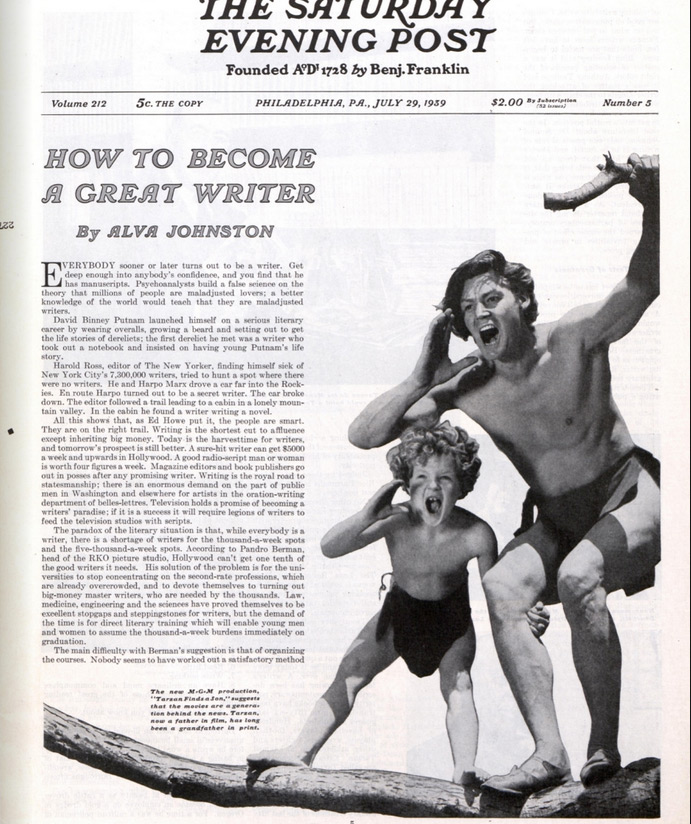
The Buried History of West Virginia’s Coal Wars
Unlike most holiday imagery, a symbol for Labor Day can be difficult for many Americans to conjure. Is it a muscled arm wielding a tool? An American flag? The dreaded hammer and sickle?
To West Virginians like Wilma Steele, the perfect symbol for Labor Day is a red paisley bandanna. This was, after all, the unifying costume of West Virginia coal miners during the largest labor uprising in American history.
Steele is a board member and co-founder of the West Virginia Mine Wars Museum, a humble collection of artifacts and displays in Matewan, West Virginia. The museum is one of the only surviving testaments to the struggles of the state’s coal miners in the early 20th century – a labor story that Wilma believes more people ought to know.
Matewan sits in Hatfield-McCoy country, in the southwest corner of the state, just across the Tug Fork River from Kentucky. The town of 500 people includes a downtown district designated a National Historic Landmark for its role in the escalation of the mine wars.
At the turn of the 20th century, southern West Virginian coal miners faced uniquely squalid working circumstances. While the United Mine Workers of America had organized many of the mines in Indiana, Ohio, and Pennsylvania, mine owners in West Virginia discouraged their workers from unionizing, hiring guards from the Baldwin-Felts Detective Agency to squash dissent and evict striking miners. West Virginian mine workers lived in company housing and bought their groceries (and mining tools) from company stores with their pay, a company currency called scrip.
Mary Harris “Mother” Jones, a brassy and bold labor leader, began speaking to miners around the state in the 1890s, giving powerful calls to action laced with obscenities. According to James Green’s The Devil Is Here in These Hills, a U.S. district attorney “named her ‘the most dangerous woman in America’ because she could, by her own words and deeds, persuade hundreds of men to walk out the mines.”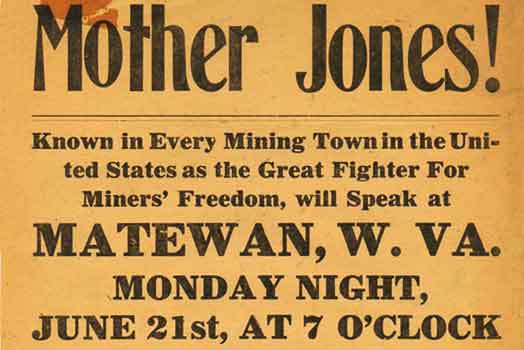
And she did. The Paint Creek-Cabin Creek strikes brought a year and a half of armed conflict between miners and mine guards to the Kanawha Valley southeast of Charleston in 1912. After striking for better wages, an eight-hour workday, and the right to assemble and organize – all having been afforded to their northern counterparts – miners were evicted from their houses and took to canvas tents in the hills provided by the UMWA. Mother Jones called on the workers to take up arms against the Baldwin-Felts agents, who had shot at the miners’ tents from train cars, and the workers retaliated. Miners fired on trains bringing in mine guards and strikebreakers and blew up railways with dynamite. Governor William Glasscock declared martial law and sent the National Guard to bring order to the region three times, and his successor Henry Hatfield finally established a lasting – albeit all-around unsatisfying – negotiation between mine owners and strikers.
The West Virginia mines saw relative peace during World War I, but the next eruption of violence put little Matewan on the map in 1920. After a significant rise in UMWA membership in Matewan, Baldwin-Felts agents arrived to oust union members from Stone Mountain Coal Company housing. The town mayor, Cabell Testerman, and union-sympathizing police chief, Sid Hatfield, confronted the agents near Matewan’s train station on their way out, and the ensuing shootout left 10 dead: seven agents, two miners, and mayor Testerman. No one could agree on who shot first, but the Matewan Massacre rallied UMWA members in West Virginia to boost their southern membership and begin a general strike.
Martial law was declared in Mingo County, and scores of miners were arrested under suspicion of union activity. The governor sent over 1,000 special police to Mingo, strengthening UMWA claims around the state that the county’s miners were under attack.
Meanwhile, Sid Hatfield was acquitted in the murder trial and became a hometown hero to Mingo County miners. But when Hatfield and his deputy were gunned down by Baldwin-Felts agents on August 1, 1921, the already-volatile strike became an all-out war.
“The only way to get your rights is with a high-powered rifle,” claimed organizer and longtime miner Frank Keeney, as he gathered thousands of miners in Lens Creek in the weeks following Hatfield’s assassination. The “Redneck Army” consisted of immigrants, black miners, and generational West Virginians wearing red bandannas around their necks. The plan was to march to Mingo County to free their jailed comrades, but first the army would have to cross Logan County, where Sheriff Don Chafin had assembled the Logan Defenders, made up of thousands of local and state police as well as Baldwin-Felts agents.

The 10,000-strong Redneck Army clashed with the Logan Defenders at Blair Mountain. Chafin’s men utilized machine guns and even biplanes with homemade bombs against the miners in the five-day skirmish. Even so, only about 20 men died overall in the Battle of Blair Mountain. Two thousand federal troops broke up the fighting and dispersed the respective forces under the command of President Harding.
The leaders behind the Redneck Army, Keeney and others, were indicted for state treason, but most escaped conviction. The harshest blow was to the UMWA, whose numbers dwindled in the coming decade. It wasn’t until F.D.R.’s New Deal programs of the 1930s that the miner’s union picked up again.
The stories of Mother Jones, Frank Keeney, Sid Hatfield, and the rest of those involved in the mine wars were kept among West Virginians for generations – along with the physical remnants of the state’s difficult past.
Long before they opened the Virginia Mine Wars Museum in 2015, Wilma Steele teamed up with some other West Virginians to incorporate their heirlooms, artifacts, and local history in a way that could benefit everyone. A canary cage used by miners during the period kept the birds that would warn the workers of dangerous methane in the mines. Oil-wick cap lamps kept an open flame on a wick attached to the workers’ hats that both allowed them to see their work and also posed the severe risk of igniting explosions. Metal scrip pieces could buy provisions at the company store while only going for about 75 percent of their worth for cash. Rusted remnants of an 1873 Remington carbine and some bullet casings recovered from Blair Mountain illustrate well the tools of a miner who has put down his pickaxe.
Kimberly McCoy, a museum guide who grew up in Matewan, shows guests the bulletholes on the back of the museum’s brick building from the Matewan Massacre while explaining how folks in town always felt about “Smilin” Sid Hatfield. “Children around here are generational coal-mining children. They need to know how their grandparents and great-grandparents struggled for them to be able to choose a profession today instead of going into the coal mines at 15 years old,” she says.

The museum believes the story of the mine wars should be taught to all West Virginian schoolchildren. That’s why, this year, they’ve created curricula for fourth-, fifth-, eighth-, and eleventh-grade students to learn about the decades-long struggle of the state’s miners. Given the complicated and contradicting historical accounts of the events, students are encouraged to read primary sources and think critically about the working conditions of miners and child laborers and to take part in role-play, considering how they would’ve acted 100 years ago.
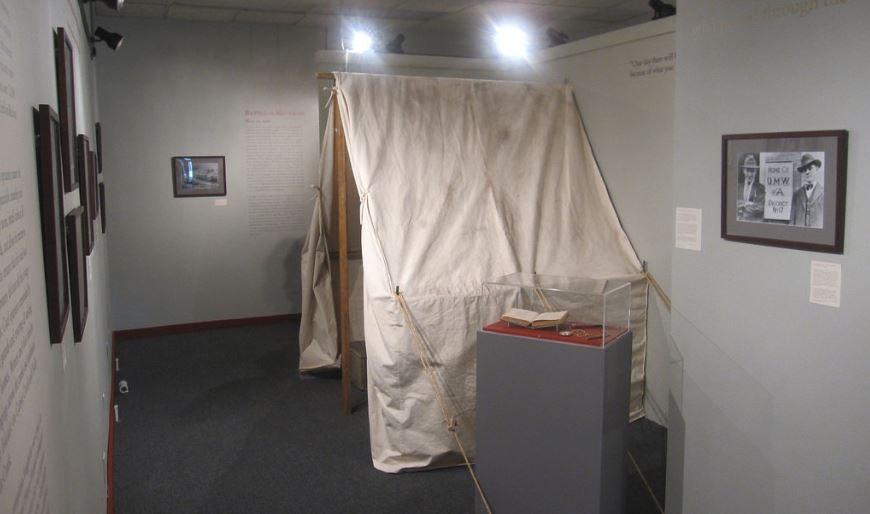
Keeping the history of the mine wars alive for West Virginians has been a battle of its own. In 2011, Wilma Steele marched on Blair Mountain with hundreds of others in the group Appalachia Rising to call for an end to mountaintop removal mining and declare the mountain a protected historic site. The place where 10,000 “rednecks” took up arms against big coal was, coincidentally, at risk of being mined itself by several companies who claimed surface mining permits on Blair Mountain.
Mountaintop removal mining began in the 1960s, but it became more prevalent in Appalachia in the ’90s. The widely-criticized form of coal mining is executed by blasting off mountaintops with explosives to reach coal seams underneath. According to the EPA, mountaintop mining poses significant risks of contaminating nearby streams and rivers. Many Appalachians, like Steele, have long opposed the practice because of the detriment on nearby communities: deforestation, loud explosions, and dust accompany the mountaintop mining process. The landscape is often spoiled, and the number of jobs created in the region cannot begin to reconcile with the damage.
Blair Mountain Battlefield was listed in the National Register of Historic Places in 2009, then de-listed after a few months due to objections from the coal companies with permits in the area. Just this June, the site was added back to the list after years of legal battles and advocacy from groups like The Sierra Club and Friends of Blair Mountain.
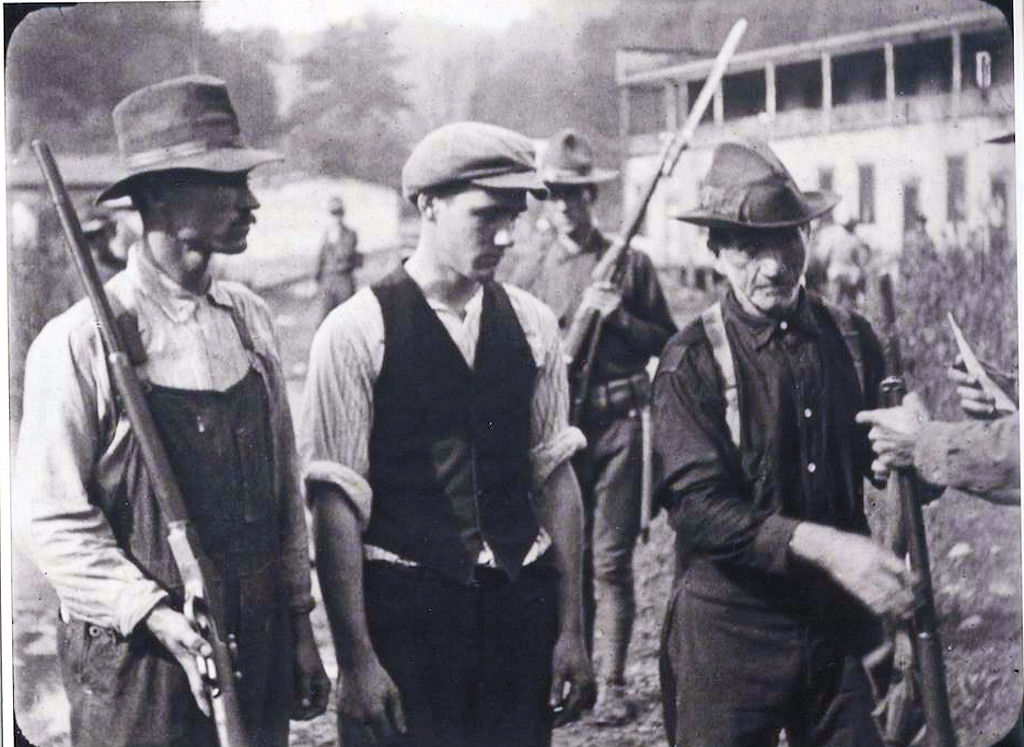
The spirit of the Redneck Army was also present in the state this past February when West Virginia public school teachers protested in Charleston during a nine-day strike for higher wages while wearing red shirts and – for some – red bandannas. The demonstration set off a chain of teacher strikes and marches in Oklahoma, Arizona, and Kentucky.
Wilma Steele believes in the historical significance of the red bandanna, and that’s why she shares them with activists everywhere she goes. “The paisley pattern on a bandanna shows organic designs and geometric designs in balance,” she says, “the figures in paisley could look like a tear, or a drop of blood, or they could come together to form a heart.” Her husband Terry was a 4th-generation coal miner, and he belongs to UMWA 1440 in Matewan. The building housing the union presides over the historic town, and it’s a short walk from where Sid Hatfield confronted agents from Baldwin-Felts. Kimberly McCoy comes from generations of miners too. The historic labor struggles of West Virginians might be difficult for outsiders to grasp, but – like the bulletholes in the brick of the museum’s exterior – the implications of the mine wars are imprinted on the people. “I know the history,” McCoy says, “it’s my history.” When asked what the stories of Sit Hatfield and Frank Keeney can mean for others, she says, “We are the story of the working class. We’re proud of rednecks here.”
Sources and further reading:
The Devil Is Here in These Hills by James Green
Life, Work, and Rebellion in the Coal Fields: The Southern West Virginia Miners, 1880-1922 by David Corbin
http://www.wvculture.org/hiStory/journal_wvh/wvh50-1.html
https://www.pbs.org/video/american-experience-mine-wars/
Eleven Jewish Korean Vets
“You come from a family of addicts,” her mother warns her. Amy’s been slipping away to the alley behind their Chicago apartment for many more purposes than her mother knows. But her mother has just washed Amy’s favorite jacket, and behold! (oy!) found a soggy remnant of a cigarette stub in the pocket.
Amy the adult will hate cigarette smoking, although she will not be averse to inhaling a little weed now and again. As an 8-year-old, however, her main concern is simply for the safety of her secret stash of Camels hidden under a pile of abandoned Barbie dolls in her closet, cigarettes stolen from E.J. Korvettes, a mere three-block walk from most points of her limited universe.
Despite the confines of her narrow existence, Amy manages to do as she wishes; the secretness of it all, a thing she loves. She is an impetuous, strong-minded child who steals candy, cigarettes, pen knives, small toys — whatever she can easily slip inside her pockets and later stash in the several hiding places she’s discovered around their apartment and in the alley. She also loves to toss basketballs in the alley with some very adult butch women, a thing she will always love to do.
Now watching her mother’s face gradually go from bright red to pink, she understands her mother’s anger is already fading. Her mother is an intelligent woman with the long, slender fingers of a musician and a razor-sharp tongue, though her anger tends to flicker out nearly as fast as it flares; a woman who is as easily distracted by a bug on the wall as a cool fall breeze, or a memory that floats behind her eyes and lands squarely on the forefront of her mind.
Amy calls her parents Mitzi and Morris. Jewel, her sister, she calls Butt Face or sometimes just Butt.
At 13, Jewel weighs more than her mother, Mitzi. More than her father, Morris. She was named Jewel after Morris’ mother, a fact she will never forgive. In the dark shadows of their bedroom, Jewel has confided to Amy she would give up anything, anything at all except maybe food, to have a name like Susan or Linda, or even Babs.
Their father Morris’ addictions are Peppermint Schnapps, baseball, and sleeping on the couch in daylight hours. He works nights driving a cab and these are the only hours on the couch he has. Amy ignores him, ignores everything that doesn’t concern her, which of course is everyone and everything — perhaps the ‘things’ most of all. All the heavy furniture, doilies, old gray-and-white family pictures, silver candle sticks, hand-dipped Shabbat candles, buffet overflowing with Passover dishes, silver platters, stupid ceramic figurines — far too many to count — things which seem to Amy to be overtaking the house, crowding her out.
She will grow from a skinny, 8-year-old tomboy into a small-framed, femme woman, which to a 20-something Amy will mean she fusses with her hair and cares what she wears. Later, her femme identity will acquire more nuances — a certain fluid walk, talk, at times a stance with hands in pockets, as if fearful of what her hands might do if free. She will be attracted to women but there will also be two or three men in her life. She will consider herself a primarily woman-identified woman and (although not strictly) a monogamous person. When she is with women, she won’t think of men at all; then again, there will be a few men she sometimes thinks about, mainly Richard Gere types, i.e., handsome, sexy, and emotionally distant. This might apply to anyone to whom she will be attracted.
Amy the adult will be much like Amy the child, who is attracted to those things not easily within her reach. At eight, she has been shoplifting for over a year and is now quite skillful at it. And there are many stores within walking distance from her school in which to apply her natural aptitude. Amy goes to a public school close to a candy store, drug store, the A&P, and of course E.J. Korvettes.
Amy has always loved that store, maybe even more than Mitzi, and while Mitzi shops for Playtex bras on sale and discount shirts for the family, Amy lifts a set of press-on nails and a Swiss army knife look-alike and slips them into the pockets of her favorite jacket. With elastic around the bottom that hugs her slim hips, it sports a zipper instead of buttons and has two deep pockets both inside and outside. It is 100 percent a boy’s jacket, all the more reason it’s Amy’s favorite, an unconscious but wise choice of Mitzi’s, pulled from a Korvettes sale bin.
Heading home from their shopping trip, the air is brisk and the streets are filled with the woody smell of burnt leaves. Autumn is Amy’s favorite season. She is happy to be skipping through the fallen leaves alongside Mitzi, who swings her arms filled with bags of discounts; she is lighthearted and even cheerful, and then Mitzi announces Amy needs to start Hebrew school so when she reaches 13 she can be bas mitzvahed.
Amy couldn’t care less about being bas mitzvahed. She could care less about religion and even less about being Jewish, which in her 8-year-old opinion has some pretty stupid traditions. She’s been grounded more than once for putting meat silverware into the dairy drawer. She’s never tasted bacon or been allowed inside a McDonald’s, nor has she ever awoken to Hanukkah presents lying in sparkling splendor under a Christmas tree. Why does she need to be bas mitzvahed if she never intends to be Jewish? “Why can’t we be Catholic?” she asks Mitzi.
“You think that’s better? You think you can throw away your ancestry so easily? Well guess what? Guess where E.J. Korvettes gets its name? Take a guess.” Mitzi doesn’t wait for an answer. “Eleven Jewish Korean Vets,” she says, and smiles smugly.
“So?” Amy refuses to show it, but she is surprised. Surprised all the way down to the toes wiggling inside her scuffed-white Keds.
“So you love Korvettes,” says Mitzi. “And it’s Jewish.”
She will never go there again, she sulks, but her fingers are crossed. She has loved that store for as long as she can remember. Longer it seems to her than she’s loved Mitzi.
She would also rather eat bugs, eat dirt, do almost anything than go to Hebrew school. She bounces on the sidewalk, stamping the crisp leaves underfoot as she deftly skips over the cracks, and makes her plans. She’ll make jokes in class and not do her homework. She’ll go behind the temple and smoke Camels and get expelled.
By the time she has thought of all the plans she is able, they are home. Amy heads for the bedroom and plops down on her bed. She is thankfully alone, her sister somewhere else, likely stuffing her face. Her eyes close and behind her lids, she silently greets her friends, Sheri and Diane. She greets them silently because of course they have no need to speak — each knows what the other is thinking — and moments later the three do what they always do, which is to hold their thin arms straight out in front of them and take off out of Amy’s window and over her house with its rules about this and its rules about that. They easily navigate themselves above the tallest buildings, houses, parks and within minutes traverse the great expanse of Lake Michigan to the opposite shore where their hideout lies — a cool, craggy, magical cave, filled with Amy’s stolen loot: three Swiss Army knives; a small screwdriver set; a handheld, battery-run tape player; a collection of the Shirelles (“Will You Love Me Tomorrow,” “Soldier Boy,” and of course, “Tonight’s the Night”); two packs of unfiltered Camels; a bag of richly colored glass and quartz marbles; and a cache of Hershey bars. A fine haul, they agree. They listen to the Shirelles while they smoke their Camels and fly in circles around the cave, joyful and buzzed, their gangly bodies free, replete with delicious grace.
Her imaginary adventures with Sheri and Diane will fade with time, almost certainly by the time she reaches the seventh grade, the beginning of her social anxieties. Looking back, Amy the adult will long to recapture the exhilaration of her youthful imagination. She will remember how her flying friends helped her endure a year of Hebrew school, and how she got out of going back for another year of Hebrew school by purposely flunking out, her (and their) best idea yet. She will also remember the lifting of items and hiding them in the alley behind their apartment building, events that will seem to be linked together in her mind as if they have melded into one. Other details, like the now defunct Korvettes department store she so adored and yet wished to disavow, will fade away, a fuzzy memory floating underneath the surface of her mind nearly full with the urgency of everyday things.
Her adult mind will work in a diffused, sometimes incoherent manner, leaving her to wonder exactly what those daily urgencies are. Other times, memories of the past will push up to the edges of her mind and present themselves with great clarity. Memories of being a wild little kid with a flat chest and long, stick-like legs, her childhood mind on the simplest things: not getting caught doing the things she loved, not getting lectured on the family’s addictions, and not having to be bas mitzvahed. Big deals to a kid, her adult self will suppose.
Her sister, Jewel, will go through the whole bas mitzvah thing, and in her 20s become a fearsome coke head. In her 30s, she will voluntarily enter rehab, and marry for the first time at age 40 to a divorced man who pays most of his commissions to child support for his three semi-grown kids.
But Amy the child has too many of her own devils to deal with to pay much attention to Jewel’s current addiction, which of course at 13 is food.
With no small amount of irony (which she will appreciate many years later), it is at Amy’s beloved, bedeviled Korvettes where she gets caught red-handed. In one deep pocket of her fall jacket is a twenty-dollar bill, stolen from her mother’s purse, and in another, a thimble and a pair of sewing shears lifted from Notions. Moving onto Records, she has just placed her hand on a tape by The Supremes, when a tall, prickly-faced boy suddenly grabs her by the jacket sleeve and drags her into the aisle.
“You’re dead meat. I gotta take you to the office now. You know what that means?”
Amy could guess. A picture of fat Butt Face Jewel laughing at her, of Morris and Mitzi yelling at her and maybe grounding her for life, flashes through her brain. She tries thinking of something to say, anything at all, only to discover her brain has stopped working and is trembling like the rest of her, making her tremble all the more.
The boy can see her skinny legs shaking in her pedal pushers. By God, she is one of the scrawniest human beings he’s ever seen. This is his first job, his first promotion from cashier to security one week ago today, and he takes it all very seriously. Serious enough to grab an 8-year-old by the britches and haul her skinny ass to the Security Room. If need be, he’ll carry her there.
Later in life, when her girlfriend stuns her with her sexual prowess, Amy will be shocked to realize she can still be surprised. She will have become a woman who considers herself a person no longer able to be surprised by much in life, who can count on one hand the times she was ever surprised. The day she got busted in the Record department, the day she found out she could hate something she also loved, the first time she made love to a woman and discovered there was no turning back. She will be able to add to her list this woman who gives her an orgasm so fierce her legs shake afterwards for hours. A little like her 8-year-old legs now dangling from a chair in the Security Room as she waits for Mitzi to arrive.
“There are two things I can’t stand: a sneak and a thief,” says Mitzi. Heading home, Amy stepping on the cracks (break your mother’s back), Mitzi so angry she is nearly running. She tosses out question after question. “Don’t we give you all you need? What am I going to do with you? What? How am I going to tell your father? Where did you get twenty dollars anyway? And why would you steal if you could buy it?” Amy doesn’t know, doesn’t know, doesn’t know. Perhaps she will never know.
Not even when she turns 30 and goes into a year of costly therapy will she receive an answer to these questions. Perhaps if the therapist were to tell her stealing was an act of self-love, a way of giving yourself something you want for the pure pleasure of taking it, she might believe it. But the therapist will be a pretty Jewish woman with intelligent brown eyes and big hoop earrings who will invite her out for a drink after their fifth session. A woman more interested in getting into her pants than her brain. Not that Amy won’t be aware.
Amy will be aware of many things during her short year of therapy. Among other painful memories, she will recall she had few real friends before college and ponder the reasons. She may have been a skinny teenager, but if her lovers were any judge, she was definitely not ugly. And she was sometimes entertaining, wasn’t she? Or adventurous at least. Why was it so hard to make friends?
Was she too eager? she will wonder, or too standoffish? Did she reek of desperation, or don’t-come-near-me? High school was the worst of all. She was a good student when she put her mind to it, which was not often. And there was that confusion about friendships and loyalties, and about boys, and girls who didn’t like her clothes, or her sense of humor, or her boastful stories of getting high smoking weed behind the gym during football games with her boyfriend, whomever that was, depending on the day, the month, the year. At least the boys liked her well enough.
In primary school, she will tell the therapist, she had yet to fall in love, although she certainly had her share of crushes — with a tough boy in the seventh grade who bragged he stole cars, with Sally Metzger, a girl in her third-grade class who already had budding, young breasts, and of course, with all of the butch women with whom she played basketball.
One of the butch women in particular, she will remember, was maybe 15 or 16, a lot younger than the rest. She was a tall young woman who gelled her barber-trimmed jet-black hair up into short, sharp spikes. Amy will recall how she was unable to look away from her beautiful milky skin, intense, dark eyes, and those powerfully built arms of hers, so easily able to smack the ball out of Amy’s tiny child hands that were working so hard on mastering the fine points of a defensive slide. She often dreamt of those arms encircling her, pulling her up against the woman’s strong, lean body … Ah, Tara, she will think, her nipples suddenly standing at attention.
Then in her freshman year at college, she will admit to the therapist, she had fallen in love with her roommate’s boyfriend. She was able to set all thoughts of Tara aside, and in fact all thoughts of women were put into a box and locked in a drawer as the intensity of this boy’s emerald eyes sent chills down her spine.
How confusing life is, Amy will think at 8, and then 18, and then one day realize she had experienced herself throughout the decades without noting or observing them, until here she was, a woman in therapy, a woman who perhaps had yet to accept who she was — though even that wasn’t clear — but when it came right down to it, age didn’t seem to matter at all. You could be any age and still be confused.
Then other days, she will see things quite clearly. On these days she will see, for instance, the therapist’s ethics really do stink. But Amy’s attraction to her will be as powerful and mystifying to her as the itch to steal, an itch that thus far as an adult, she will have scratched only once or twice (when the mood and an irresistible occasion coincided), leaving her bewildered and frustrated that her principles aren’t stronger.
The therapist will want to dig into Amy’s past as a way to explain where she is today (which is where? Still anxious, still moody, not exactly happy with herself?). But Amy will spend most of her time in therapy avoiding the subject. Sick of the sound of her own whiny voice, she will be unable to think of anything about her family that could possibly be relevant.
“Let me decide what’s relevant,” the therapist will tell her.
Towards the end of her time in therapy, Amy will come to the conclusion something is sorely missing. Longing for something she can’t quite place, she will eventually find it in Neiman Marcus.
She will catch a young woman’s eye as the woman picks up a T-shirt and begins to walk towards the dressing room. The woman’s furtive glances, the way she holds herself, as if ready to run — Amy will know instinctively the woman has no intention of buying the shirt. She will wait until, sure enough, the woman slips the thin T-shirt easily into a deep pocket of her jacket and soon after exits the store, Amy a few steps behind her. It will become the beginning of their relationship, a story Amy will tell to the therapist, if for no other reason than to watch her discomfort, which Amy will feel the therapist richly deserves.
The therapist will take her to the opera and to plays — always tragedies — and afterwards, to some hip after-theater restaurant where the therapist will seem to always run into one of her self-important friends. But the sex is phenomenal, and Amy will be loath to give it up, perhaps because she and new girlfriend are not yet having sex — the new girlfriend’s idea. She’s old-fashioned, or so she says. Actually it will be because she prefers not to compete. The girlfriend will be a non-confrontational pacifist through and through, from her clumsy square-toed shoes to her flowing, ash-blonde ponytail. And anyway, the girlfriend will know, a little wanting can go a long way.
Amy will spend most of her time with the girlfriend in the mall shoplifting, an activity akin to the thrill of the hunt. The chase and kill will be what it’s all about for them both. For Amy, it will also call up her days dribbling a basketball across the alley, dodging Tara and the onslaught of her large butch friends ready and willing to steal it away from her small, nimble hands. To Amy and the girlfriend, the ‘chase and the kill’ will not be mere code words, but as exhilarating and satisfying as the most outstanding sex between them might be.
Then while in Lord & Taylor one afternoon, the girlfriend will be playing the chaser asking to see the earrings behind the locked case as Amy meanwhile expertly kills several pair of gold earrings from the counter and slips them into her pocket. It will be a neat little job, one they are quite satisfied with, but as they exit the store, an inner alarm will suddenly go off inside the girlfriend’s head.
“Toss ’em,” the girlfriend will whisper fiercely, and Amy will ditch the earrings as fast as she can as two security guards approach.
One of the security guards will be a hefty woman with small black hairs poking out of a mole on her cheek. “Up against the wall,” the guard will growl with her tough-as-gristle voice.
As the woman pats her down, Amy will shudder inside. This will be no small pocked-faced boy grabbing her by the scruff of her collar.
The girlfriend will admit to Amy she was plenty scared, but also excited. Amy will understand. It will be this sort of moment that she has dreaded and thrilled to most of her life.
“But mostly dread, you know?”
The girlfriend will know. It’s the reason, she will tell Amy, that she wears her hair in a ponytail: to affect a look of innocence. “But not foolproof, eh?” she will smile. Her smile is a bit sideways, Amy will notice. Very sexy.
Amy will soon stop dating her therapist and start dating the girlfriend exclusively. But for now, Amy will be happy with things as they are. And at the moment they are: the therapist, the girlfriend, and Amy sitting on Amy’s couch getting stoned, listening to Melissa Etheridge burn down the house.
The cannabis is prime, and Amy’s head will already have begun to feel like it’s underwater, when she will think maybe she should quit the therapist once and for all, an idea that will feel like a grand revelation. That, or perhaps there is potential here for a threesome.
The therapist will be under the impression it is simply Amy’s addictive nature which prevents her from leaving her. In fact, she will be counting on it.
Amy will think, it’s like that old joke about the woman who goes to her psychiatrist, who tells her, “My dear, you’ve got a chicken on your head.”
“Have you heard this one?” she will ask them both.
The therapist will shrug, affecting a look of mild boredom, for surely it will not have been her idea that the girlfriend join them.
The girlfriend, on the other hand, will smile her sexy sideways smile. “Hit me, babe,” she will say, the girlfriend’s uncharacteristic use of the word ‘babe’ sending a chill down Amy’s spine.
At that moment, Amy will see that in a rough sort of way, the girlfriend is quite attractive; feature for feature, maybe even more attractive than the therapist. The girlfriend is what the therapist calls ‘soft butch,’ a category in which the therapist lumps all the quiet or non-aggressive types who aren’t femmes. But Amy won’t care what the therapist calls her, she’s got two girlfriends now (if she counts the therapist), and a year ago she had none.
“So the woman says to the psychiatrist, ‘Yes, I know there’s a chicken on my head.’
‘My dear, why not simply remove it?’ the psychiatrist asks.
‘Well I would,’ says the woman,’” (and here, Amy will pause for affect) “‘but I need the eggs.’”
The therapist will arch one humorless, crescent-shaped brow, suggesting volumes — irony, smugness, disdain.
While the girlfriend smiles. “Love it!” she will say, and wink at Amy, a powerful suggestion to Amy’s roiling mind that will conjure the twinkling lights of Christmas.
The girlfriend will soon walk into a barbershop and watch as the barber cuts off her ponytail in two quick snips. “Ah, just as well,” the girlfriend will sigh, watching mounds of ash-blonde hair cascade to the floor. She’s pressed her luck long enough.
Amy will hate the girlfriend’s haircut, loathing the understanding their shoplifting days are over, days for which Amy will already be pining. If only she didn’t adore the girlfriend’s smile, her sense of humor, the simple, not-so-simple fact the girlfriend really gets her. Well, she will just have to get over her, Amy will brood. She will simply not call her, not even accept a date for coffee. Not even if begging is involved, not even if the girlfriend promises new thrills, or even a promise of the best sex ever. That’s that, Amy will think, no matter what eggs she offers.
But of course, her fingers will be crossed.
Now, her fingers are itching, itching to play ball. Leaning on the window sill (grounded for life), supported by her elbows, her face in her hands, she looks out on the alley where Tara and her butch women are dribbling a basketball up and back the long stretch of concrete.
Mitzi is in the kitchen, the smell of chicken fat drifting through the crowded apartment. Morris is sprawled on the couch, one arm slung over his tired gray-green eyes, a half-full glass of Schnapps within reach on the coffee table. He leaves the television on, blaring out the news of the day, Amy’s heart thumping as she is half expecting to hear about herself getting caught at Korvettes on news. Oh, but to forget all that and feel the leather of the ball between her hands, the shouts of the women, and the sweet smell of their sweat all around her. What she wouldn’t give to be down in the alley now, Tara’s gruff, eager voice calling her: Over here little Highflier, over here!
News of the Week: The Joy of Pencils, a Musical Lawsuit, and Burgers and Shakes for Labor Day
No Siree, My Clue Was Good, I Can Prove It!
School has started — or will soon be starting, depending on where you live — and that means all of the kids and their parents are going to Staples and Target to buy their school supplies. I won’t pretend I loved school when I was a kid, but I certainly loved buying all of the notebooks and pencils and other things I would need for the school year. Funny how I never used a pen as a kid; it was always a pencil. Now I’m starting to get back into pencils, thanks to discovering the Blackwing line. I spend way too much money on writing utensils and paper products.
CBS This Morning’s John Dickerson is also a notebook and pen aficionado, and here he talks about his love of pencils, the memories they invoke, and how they can be a tool in the war against information overload and being in front of a screen all day.
By the way, bonus points to anyone who gets what I’m referring to with the “no siree” line. No fair Googling! If you give up, here’s the answer.
Breaking News about “Breaking News”
This hasn’t been a good month for Michael Jackson.
Last week I told you that the Eagles had overtaken the King of Pop for the No. 1 spot when it comes to album sales. Now we find out that some songs on an album released after Jackson died might not even feature his voice.
There’s a class action lawsuit going on involving Sony and fans, and many online news sources reported that Sony actually admitted the songs weren’t sung by Jackson but by an impersonator. But that’s not exactly what lawyers for Sony said. They were giving a hypothetical legal argument based on the merits of the case and said, “even if the vocals weren’t Jackson’s …” Of course, some people might think that just bringing up a defense like that means it’s possible the songs are sung by someone else.
This actually isn’t a new story. Rumors have been swirling since the album Michael came out in 2010 that the vocals aren’t Jackson’s, and while members of Jackson’s family at first said it was him, some of them now aren’t sure. You can judge for yourself. Music experts say it’s Jackson. Here are “Breaking News,” “Monster,” and “Keep Your Head Up.”
Booze News
Don’t drink alcohol.
That seems to be the results of a new global study published in The Lancet last week. In fact, experts are saying that no amount of alcohol is safe. It’s the type of news that makes you want to, well, take a drink.
This comes many years after all the experts told us that one glass a day of red wine is good for us. Now it seems that all alcohol has turned into battery acid or something. But hey! Here’s an expert who says that we shouldn’t panic. (I choose to believe this expert.)
But even if it turns out alcohol isn’t good for us, we can still eat meat and cheese and chocolate.
Back to school. pic.twitter.com/K5ifoR6SV7
— You Had One Job (@_youhadonejob1) August 25, 2018
The Old Man and the Gun
Robert Redford announced recently that he is retiring from acting. Here’s the trailer for his last movie, The Old Man and the Gun, which will be released on September 28. Looks good!
Chicago, 1968
This week marks the 50th anniversary of the 1968 Democratic National Convention in Chicago, an event marked by riots, arrests, and CBS newsman Dan Rather getting punched on live television. It was just one of the many intense events of a very tumultuous year, as Daniel Patrick Moynihan wrote in the classic Post article “Has This Country Gone Mad?”
RIP John McCain, Neil Simon, and Robin Leach
John McCain was a war hero, a longtime Arizona senator, and the Republican nominee for president in 2008. He died Saturday at the age of 81.
Here’s McCain’s farewell letter to the nation, and here’s what fellow senator and close friend Lindsey Graham had to say about McCain a few days ago.
Neil Simon was the acclaimed writer of such plays as The Odd Couple, Barefoot in the Park, Come Blow Your Horn, Sweet Charity, Lost in Yonkers, and Biloxi Blues. He also wrote several screenplays and worked alongside Mel Brooks and Carl Reiner for the classic 1950s variety show Your Show of Shows. He died last week at the age of 91.
Robin Leach was the man who wished us “champagne wishes and caviar dreams” on the popular show Lifestyles of the Rich and Famous. He died last Friday at the age of 76.
This Week in History
Lyndon Baines Johnson Born (August 29, 1908)
Author Robert Caro has been writing a multi-volume biography of the 36th president, starting with 1982’s The Path to Power. He’s working on the final book in the series now. Late-night host Conan O’Brien, a huge fan of Caro’s, has been trying to get the writer on his show for years, to no avail. But he’s not going to stop trying.
Beatles’ Last Concert (August 29, 1966)
This was the last concert that John, Paul, George, and Ringo put on … unless you count the impromptu performance on that roof.
This Week in Saturday Evening Post History: Postcards (August 25, 1951)
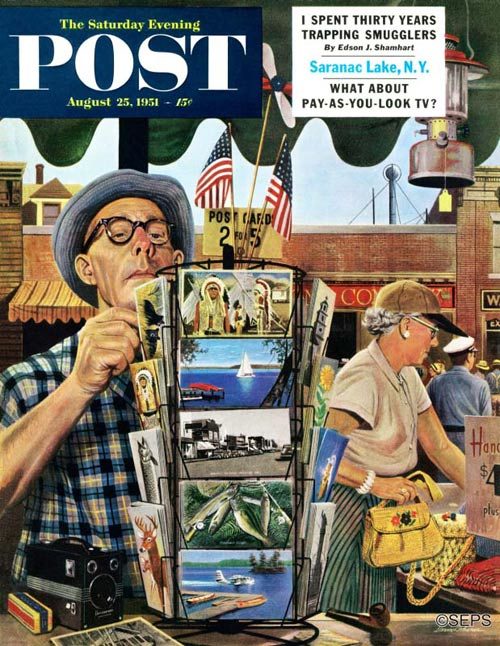
Stevan Dohanos
August 25, 1951
What I love about this Stevan Dohanos cover is that it takes something rather mundane — buying postcards during a summer vacation — and makes it rather beautiful.
End of Summer Recipes
Sure, I can call this section “End of Summer Recipes,” but it’s hard to do that when I’m sitting here in 90-degree temps and dew points in the 60s. Just as I finished that sentence, the power went out for a few seconds. Now I’m typing this knowing it’s not going to be saved until my internet comes back. This is the second time the power has gone out today. Funny, I can go through an entire winter of storms, with wet snow and ice and intense winds and not have one power outage, but when it’s really hot, I can get two in one morning.
But Labor Day marks the official (or is that unofficial?) end of the summer season, and here are some recipes to try this weekend. How about these Sweet Hawaiian Mini Burgers or this German Potato Salad, which uses mustard instead of mayonnaise, so millennials will like it? For a refreshing drink, you can try this Vintage Lemonade, and for dessert this cold Hershey’s Chocolate Milkshake.
Now if you’ll excuse me, I have to go turn my fan back on.
Next Week’s Holidays and Events
V-J Day (September 2)
This marks the day that Japan surrendered to the Allies during World War II. It can be a confusing holiday because “V-J Day” can be a reference to the day that Japan’s surrender was announced (August 14 or 15 in the UK and other places, depending on your time zone) and September 2 in the US, which is the day that Japan officially signed the surrender papers.
Labor Day (September 3)
Here’s a gallery of Post covers that show how labor and the workforce have changed over the decades.
Read a Book Day (September 6)
Come on. You should read a book every day!
Seriously Good Fall Films
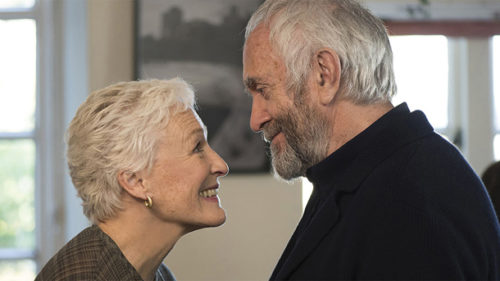
The Wife (August 17)
Fans of great screen acting can’t ask for more than Glenn Close and Jonathan Pryce as a long-married literary couple whose lifetime of shared secrets catches up with them on the night the hubby accepts the Nobel Prize for Literature. Based on Meg Wolitzer’s novel, the film explores how even mutually agreed marital ground rules can mess up life’s later chapters. Christian Slater pops up as a biographer who lives to turn over stones in his subjects’ lives. And look for Close’s daughter, Annie Stark, as the younger version of her mom’s character.
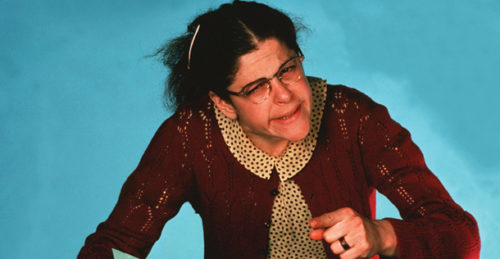
Love, Gilda (September 21)
The life story of Saturday Night Live star Gilda Radner will make you laugh and cry — often at the same time. You’ll laugh because Gilda was one of the funniest people who ever lived, and the film’s generous helping of clips includes the best of her best, from characters like crass Roseanne Roseannadana to Gilda just being herself, charming her audiences into happy submission. You’ll cry because the film follows Gilda into the depths of her battle with cancer, including heart-rending moments in the hospital. Director Lisa Dapolito smartly lets Gilda do all the talking, using rare recordings the comedian made while working on her autobiography. The world could use Gilda now; this movie makes us miss her more than ever.

What They Had (October 19)
It’s a sign of the times that many of our most captivating films deal with Alzheimer’s, the scourge of a generation. What They Had is among the best of them, exploring not just what it means to care for someone with dementia, but also what it means to keep loving them for who they are. Blythe Danner is masterful as the mom who is slipping away but clings to the remnants of her good humor like a life preserver. As her overwhelmed family, Michael Shannon is the endearingly gruff son, Hillary Swank the daughter who parachutes in when things get tough, and Robert Forster the heartbreakingly devout but ultimately overmatched husband.
This article is an expanded version of the interview that appears in the September/October 2018 issue of The Saturday Evening Post. Subscribe to the magazine for more art, inspiring stories, fiction, humor, and features from our archives.
“The Nesting Instinct” by D.K. Findlay
Summer is for steamy romance. Our new series of classic fiction from the 1940s and ‘50s features sexy intrigue from the archives for all of your beach reading needs. In “The Nesting Instinct,” from 1959, Pete will try anything to show his long-time neighbor Winona that he’s interested.
The Kuylers lived next door to the Millers. Pete Kuyler dropped in on the Millers after dinner as he usually did.
‘‘Hello, Pete,” said Mrs. Miller. “Just in time for coffee.”
‘‘Hello, Pete,” said Mr. Miller, looking up from his book. “Here’s an interesting bit; I’ll read it to you.”
“Now, father,” said Mrs. Miller. Mr. Miller was always reading bits out of books to anyone who would listen.
“Is Winona around?” asked Pete.
“She’ll be down in a minute.”
Winona came in, eating an apple and reading a book on higher mathematics. “Hello, Pete,” she said. She read them a bit from her book — it was a family failing; something about the number of uncompensated errors being equal to the square root of something.
“Pretty neat, eh?”
When it came to brains, Winona sparkled like a crystal.
“How about a movie?” said Pete.
“Thanks, but tonight I wash my hair. Why don’t you ask Eva Pullaski?”
“Because I don’t want Eva Pullaski.”
“She has a very interesting walk.” She swayed across the room in the sexy manner of Eva Pullaski, ending with a derisive flip of her derrière. “Well, I’m off to the suds.”
And she went off to wash her hair just as if Pete were calling on her mother and father and not on her. And that was the crux of the problem.
In a world full of curvy girls willing to be led to the altar, Pete persisted in being in love with Winona, a library-type girl with a figure like a beanpole, who had no plans for being led to the altar. To her, Pete was just the boy next door, whom she had known for ages. Besides the said skinny figure, she had a head of wheat-straw gold and a cool pleasant smell like a verbena.
But no yen for the men. What Winona liked was reading difficult books and eating apples. So far, she had not met a man as interesting as a good book, or even a good apple.
This was frustrating to her mother, who was solidly pro-Pete. She had known him all his life; he had a promising future in the business which his family owned. And besides, Mrs. Miller was a cheery, sociable soul, who liked weddings. That is, she liked weddings where nice boys like Pete got nice girls like Winona. Sometimes she was afraid Winona would not catch on until it was too late.
For it was clear that Pete was becoming discouraged. No one could say that he had not tried. He had done the flowers-and-candy bit for years; he had plodded through the World’s Best Books because Winona spoke highly of them, and he had bought a red sports car to dazzle her. But that was a device that had backfired. It had not dazzled Winona, but it had caused Eva Pullaski, a curvy girl who lived down the street, to pay Pete a great deal of warm attention.
Pete prepared to take himself off.
“Well, there goes the evening. I guess I’ll have to fall back on Plan B. Plan B is where the operative cuts his throat.”
“There are days when I could shake her,” said Mrs. Miller.
“Here’s an interesting bit,” said Mr. Miller. “It’s about bowerbirds, which are native to Australia and New Guinea, and are related to birds of paradise. Listen to what they do in the spring.” He read aloud from the book: “‘In the springtime, in order to attract a mate, the male bird builds a bower arched over with twigs, leaves and grass. Some of these are small and tent-like while others are long runways with a height of two or three feet. Outside the bower, the bird clears a space for a garden, a lawn of green moss, and decorates it with berries, colored stones, feathers, leaves and bright flowers — ’”
“Hey!” said Pete. He sat up. “Say!” Then he said, “Good night, all,” and vanished.
“Now what?” asked Mr. Miller, surprised by the suddenness of his going.
“He certainly went out of here under a full head of steam,” said Mrs. Miller.
Pete dropped in on the Millers the following evening. That is, he burst in like a human exclamation point.
“Guess what! I’m going to build a house!”
“Why, that’s splendid!” said Mrs. Miller. “Do you hear that, Winona? Pete is going to build a house.”
Winona looked up from her book. “A what?”
“A house! I’ve bought a lot at Heatherley Heights.”
“Pretty expensive out there?” asked Mr. Miller.
“Oh, brother! But it’s worth it. Say, I never knew about houses before. I didn’t know they could be so interesting.”
“Useful, too,” said Mr. Miller. “If it weren’t for houses, where would we put the mortgage?”
Winona was looking at Pete with interest. “Does this mean that you and Eva Pullaski — ”
Pete exploded like a firecracker. “Will you stop making cracks about Eva Pullaski and me! Eva Pullaski is nothing to me; I wouldn’t give her the time of day! Listen, Winona, this house is going to be terrific — fabulous! I’ve been up all night studying plans. It’s going to be a split- level on a well-treed lot.”
“Does that mean the trees are on the lot, or the lot is up in the trees?”
“All right, all right; have your fun. But just you wait — you wait right there — you’ll see!”
Often during the next weeks Winona looked about the room with the air of one who misses a familiar article of furniture.
“What’s happened to Pete these days?”
“He’s building a house. He told you about it,” said her mother.
“Sure enough, he did.” She thought about it for a moment. “Whatever does he want a house for?”
“To live in, I suppose. He’ll be getting married one of these days. Even if he doesn’t live in it, property out there is a good investment.”
Not only was Pete busy building, he was doing some pretty deep thinking. It seemed to him that he had got to the bottom of one of life’s mysteries. He mentioned the matter to Mr. Miller.
“Do you ever wonder why they have all these June weddings?”
“Beats me,” said Mr. Miller.
“It’s a sort of urge like the nesting season in birds. Come the spring, the girl looks round and if she finds a likely-looking nest, that’s half the battle. All these new houses are supposed to be ready in May, but they never are, so they have to hold off until June.”
“Only one thing wrong with your theory,” said Mr. Miller. “The girls get married not only in June but in January, February, March, April, May, July, August, September, October, November and December.”
“There is a tide in the affairs of men which, taken at the flood, leads on to fortune.” In other words, if you have a good scheme going for you, the thing to do is to wait for the propitious moment. Especially is this true of the building trades and houses under construction. But did Pete wait patiently for a favorable moment? Not he.
He came banging at the Miller door one raw, wet, windy March day, urging them to come out and inspect his dream house. It was no day to inspect anything, said Mr. Miller, who was lying on the sofa, it was a day not fit for man or beast. Winona toasting before the fire with a good book felt the same way.
But Mrs. Miller was loyal. “On your feet, everyone. Get your galoshes.”
They were bundled into Pete’s open car and sent hurtling through the wild wet March weather. They stopped before a drowned hillside where someone had built a foundation and stuck in a lot of two-by-fours.
“There she is,” said Pete proudly, seeing it not as it was, but as it would look when finished.
“You’ve been gypped,” said Winona. “Let’s go home.”
“We’ll come back when the flood waters have subsided,” said Mr. Miller.
“Now, father,” said Mrs. Miller.
Pete, bubbling with enthusiasm, showed them over every foot of it, over loose boards and piles of brick.
“Now this is the living room. That big hole over there is where the fireplace will be and this hole here is for the air conditioner. Underneath is the recreation room. Of course it’ll look different when the furniture is in.”
“Sure hope so,” said Mr. Miller morosely. “Right now it’s furnished with three feet of mud.”
“Notice this trench outside?”
“What do you mean, notice it?” said Winona. “It looks like Lake Erie.”
“That’s the drainage ditch. We’re going to put in weeping tile so the basement will always be dry…. Hey!”
Winona had stepped on the end of a loose plank which reared up like a teeter- totter and dropped her overboard. They got her out, minus one shoe.
Altogether it was a pretty dismal afternoon.
Pete was a going concern these days, he was really humming. He was finding that there is nothing so interesting, absorbing, rewarding and surprising as building a house. He sat up late thinking up ways to make this house better. This split-level was to be a split-level fit for a queen. A queen by the name of Her Majesty Winona Miller.
The dream house began to look like a house. The roof was on. The plumbers and plasterers were in and out, followed by the painters. It was nearly complete.
There came a fine evening in early June. There was spring in the air. There were boys and girls together wherever you looked, slightly bemused.
“Come out to Heatherley Heights,” said Pete to Winona.
“Don’t mention that place around here. Father said it gave him the worst cold he ever had.”
“The mud is all dried up. Come on, Winona; I have a surprise for you.”
They drove out to Heatherley Heights. A handsome split-level house with its windows shining sat on its immaculate greensward. Winona was astonished. She was learning one of life’s lessons for young girls, which is, you take a lot of men in overalls and set them messing about with boards and bricks and plaster and you’d be surprised at what comes out. She walked through the pastel-colored bedrooms, the dining room with the glass wall to show off the dishes, the kitchen with red brick and white plaster.
“It’s lovely. Pete; it’s really lovely.”
“I built it for you.”
“Me!”
“I’m not very good at telling you how I feel about you. I’m trying to tell you with this.”
The house was a very eloquent pleader. After this, she could no longer pretend not to know the strength of his feeling for her.
“I don’t know what to say, Pete.”
“‘Yes’ would be nice.”
“That’s the tough part. I like you better than any boy I know — but it’s not one of those deals with fireworks.” She looked around. “I rather wish it was.”
Eva Pullaski met Pete on the street. “I hear your new house is a knockout.”
“It’s all right, I guess.”
“How about showing me over it?”
“Sure, be glad to. Sometime.”
“Sometime about 8 o’clock tonight.”
That evening Winona had happened to bring home a novel of unrequited love. It was about this young fellow who loved this girl who did not return his affection, and about his sufferings, which were excruciating. It shook Winona; even though she was not in love with him, she did not want Pete to suffer on a scale like that. On impulse she called him on the phone; he was out at Heatherley Heights, his mother said, at the new house.
Winona hopped into her car and drove out.
In the split-level, Pete was explaining the different systems of heating a house — coal, oil, gas, hot water, hot air, electricity — to Eva Pullaski, who did not care much one way or the other. What Eva liked was boys, and she had been alone with this one for an hour and nothing had happened. Evidently he needed stirring. “What’s with the main burner, lover boy?”
“Huh?”
She sidled warmly against him. Naturally he kissed her. And naturally, just at that moment Winona walked in the door.
“Aha!” she said and walked out again.
Next evening Pete rang the Miller doorbell.
“This is the Miller residence,” said Winona inside the screen door. “Your bowerbird lives down the street.”
“Aw, come on, Winona. You know it didn’t mean a thing. I was just explaining about heating systems.”
“Yes, I could see that.”
“You could see other things too,” said Pete, nettled, “if you weren’t an ice-coated beanpole!”
“Is that so?”
“Yes, that’s so!”
“If you are looking for father and mother, they’re in the living room.” She opened the door and, when he came in, she stepped out and closed it.
This was a tactical error, she realized a moment later; he was inside and she was out. She had not planned to go out, but having made a gesture, dignity demanded that she stay out. She went for a walk.
Several days later, Winona happened to glance out the back door into the Kuyler yard.
“What’s the matter with Pete?” she asked her mother. “He’s sitting out there looking as if he hadn’t a friend in the world.”
“His mother says he mopes round the house. Won’t eat a thing.”
“I’ll go out and cheer him up.”
She went out into the back yard and threw an apple core at him. “What’s the matter—have you got the blight or something?”
“I’m sorry I called you an ice-coated beanpole.”
“Oh, that? Sure I’m a beanpole. Figure like a thermometer. Mother says I’ll fill out someday, but not much sign yet. How are things out at the new house?”
“I sold it.”
“What!”
“This fellow offered me two thousand dollars more than it cost me, and Eva Pullaski advised me to take it.”
She recoiled from him as if he had taken leave of his senses. “That is absolutely the dumbest thing I ever heard of! You build this beautiful house and then you go and sell it on the advice of a bird brain like Eva Pullaski. Listen, any time Eva Pullaski knows enough to come in out of the rain, that’s a brain wave.”
“But l thought you didn’t care about the house — “
“But you do! Why did you go and sell it when you personally love every board and brick in it? Men!” cried Winona. “Holy mackerel!”
She went into the house pretty indignant.
Pete came over to the Miller house.
“Nobody home but me,” said Mr. Miller. “Winona and her mother have gone to the movies.”
“I know. It’s you I came to see. I was hoping you’d give me some advice.”
“Glad to. On any particular topic, or just in general?”
“About Winona.”
“I was afraid of that. Fathers are remarkably poor sources of advice re their daughters. The general opinion is that when it comes to daughters, fathers don’t know beans.”
“I’m getting pretty desperate. A few days ago when she got mad at me for selling the house, I thought I was making progress. But when I told her I’d got it back again she just said good, that’s the stuff, as if it was nothing to her.”
“There’s something stirring in Winona,” said Mr. Miller. “I can tell by the books she brings home from the library. Up till now, it was usually deep stuff, pretty rough going for me. Like that time she took up the quantum theory, my mind was stretched like a rubber band, I figured it was due to snap any time. But look at this week’s haul—two love stories and a book on interior decoration. Last week she even brought home a cookbook. Winona, I think, is a good deal like her mother.”
“Yeah, I guess so.” Pete did not see that this was much help.
“Let me tell you about the summer we got engaged. She was a college graduate, she was a darb at the books, she thought she’d like to go back and take her M.A. Whereas I wanted her to stay home and take an A.M. — that’s me.”
“What happened?”
“Don’t hurry me, boy. I was in quite a state that summer; I tried everything I could think of. I even stopped a runaway horse.”
“A horse? I wonder where I — ”
“Nevermind. Horses are out. It didn’t do me any good; it just ruined a good suit.”
“What did it?”
“Something that had nothing to do with me at all. You know, when the girls are standing on one foot, trying to make a decision between marriage and a career, something not very large or important can tip the scales one way or the other. It seems to be the timing that does it.”
“What happened?”
“An old aunt of hers died and left her a silver tea service which she had always admired. It seemed to turn her thoughts to a home and settling down. She always denies this, but I used to say that if it weren’t for that silver tea service the world would have got another M.A. and I would have lost a missus.”
“Has Winona got any old aunts?”
“Two. Both, I am glad to say, in excellent health. … I think I hear the girls coming now.”
Winona and her mother came in. Mrs. Miller greeted Pete. “For goodness’ sake, calm down,” she said to Winona. Winona’s eyes were bright, she seemed to be walking on air. “She’s in a flat spin,” said her mother.
“What happened?” asked Pete.
Winona, who had sat down, sprang up again. “Wait till you hear!”
“We’re waiting.”
“You’ll never believe it!”
“Well, give us a chance to try.”
“And to think I nearly didn’t keep my ticket; the man at the door had to run after me with it. And when they called out my name over the loud-speaker, I just died!” She fell into another chair and died again.
Mr. Miller looked at his wife. “Kindly issue a communiqué.”
“She won a set of dishes at the Lyric. Very nice ones too.”
“Ninety-six pieces!” cried Winona. “Eight dinner plates, eight bread-and- butter dishes, eight soup bowls, eight dessert dishes, eight cups and saucers, one soup tureen, three platters, one gravy boat, two creams-and-sugars — “
“Yes, dear, we know,” said her mother.
“Pete, it was terrific! It’s the first time in my life that I ever won anything. There I was sitting there, not even paying attention — “
She told it all over again, with details. Some time later when Pete got up to go home, she was surprised.
“So early?”
“It’s midnight,” said her mother.
“Oh. Well, I’ll walk you to the gate, Pete.”
She saw him safely down the porch steps. In the most natural way she put her hand within his arm. At the end of the walk she lingered for a moment.
“See you tomorrow night, Pete?”
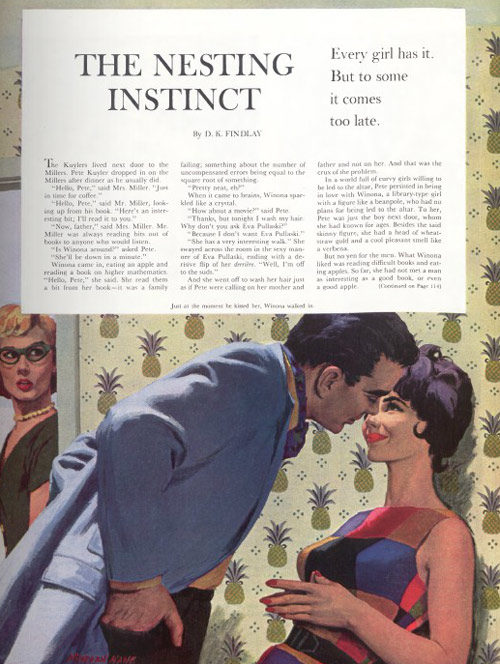
North Country Girl: Chapter 67 — The Best Job in the World
For more about Gay Haubner’s life in the North Country, read the other chapters in her serialized memoir.
Some names have been changed.
As editorial assistant at Penthouse magazine, my duties were editing the vile Letters section, a daily dose of saltpeter to my own sex life (a task I finally ditched on someone else), and taking my boss out to three-martini lunches (slugging back a few glasses of life-and-sanity-saving white wine myself).
Now that I was sprung from my smutty epistolary prison, the question was what I would do for those six hours a day I was not at lunch.
I was sent off to talk to Paul Bresnick, who had the competing titles of fiction and service editor.
Paul had literary taste of the first water backed by the deep pockets of Penthouse, which let him purchase stories and book excerpts by Gore Vidal, Philip Roth, James Baldwin, Paul Theroux, and other high flyers.
By rights a fiction editor who worked with five-star authors should be above dealing with humdrum service articles. Service supposedly meant consumer services, as if we were doing the readers a favor by running reviews of cars, motorcycles, electronics, and cameras. In reality the service we provided was for the advertisers, plugging their products in glowing terms. It didn’t matter if what you produced was a lemon; purchase a full-page ad in Penthouse and your Isuzu or Yugo would be written about and photographed as lovingly as if it were a Pet of the Month.
Paul was as eager to dump his unwanted editorial task as I had been.
“I’m flying to London tomorrow to meet with J.P. Donleavy and I’m stuck editing an article on radar detectors,” he groused.
My short stint at Viva had been all about coming up with punning headlines and appeasing advertisers. I was the woman for the job of service editor. I just couldn’t believe Paul would willingly give up such a plum, especially to someone who could barely drive a car, had no idea how a stereo worked, and had trouble focusing a camera. Despite my shortcomings, I was bequeathed the lofty title of service editor of Penthouse magazine, the best job in the world.
My favorite perks of this new gig were free meals at lavish press parties, thrown by PR agencies that seemed to be wallowing in money. In 1980 it was après moi le deluge for the automotive industry; a company couldn’t bring out as much as a new spark plug without a press conference, always held at a suitably masculine restaurant with plenty to eat and drink to sweeten their spiel.
A short-lived competitor to STP took over the top floor of the 21 Club to hype their doomed product to the car press, which was 99.9% male and then me. In between the mountainous wedge of iceberg lettuce topped with a glacier of blue cheese dressing and the Flintstone-sized T-bone, we were served a palate-cleansing consommé. The already drunken Car & Driver editor next to me nudged me in the side with his elbow and asked “Is your soup empty too?”
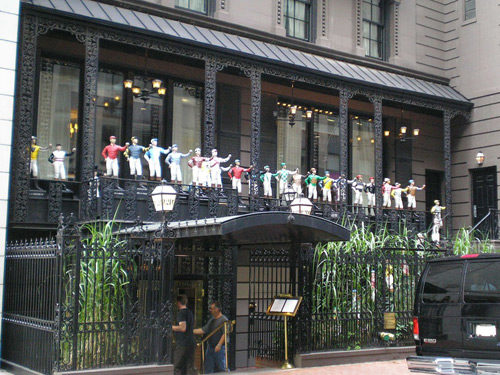
There were also invitations to test drive cars, sometimes at day-long events out of the city and sometimes really out of the city, at bashes thrown at the Greenbrier or in Palm Desert, all expenses paid. These invitations I was required to turn over to my boss, Jim Goode, the executive editor. I didn’t mind; I knew that if I were plopped behind the wheel of a souped-up car with a helmet smashed on my head I would immediately drive into a ditch.
Instead of being greeted every morning with a bag of dirty letters, I now found on my desk packages addressed to “Service Editor, Penthouse:” bottles of booze, walkie talkies, cameras and lenses, turntables and speakers and pre-amps, and yes, a Fuzzbuster radar detector, which I turned over to Jim Goode so he could speed his pups out to Shelter Island in his Lincoln Continental without being pulled over by the man. For the new service editor of the best-selling men’s magazine in the world, every day was Christmas.

Besides all the free stuff and never having to pay for a meal I could now parcel out gold-bricking service articles to my writer friends, which meant I could take them out to one lunch to give them the assignment (five minutes spent listing the companies the ad staff was pitching or pacifying, an hour and fifty-five minutes getting drunk), another follow-up lunch to go over edits (what the ad department wanted changed, then getting drunk), and cut them a nice check.
My old pal Michael VerMeulen, now relocated to New York, on his way to London and an early death, became the Penthouse liquor writer and the main beneficiary of my splurgey expense account lunches.
One day VerMeulen dropped by to pick up his money for nothing. I fetched his check and was walking him out of the office when we passed another Penthouse editor. VerMeulen’s head swiveled 180 degrees and he smashed into a wall.
“Who was that?” he gasped.
That was Zelda Fleming, our femme fatale and least-likely Penthouse editor even among our staff of misfit toys. Zelda came from a patrician New England family, had attended Miss Porter’s School for Girls, and dressed in the upper-crusty style Ralph Lauren stole.
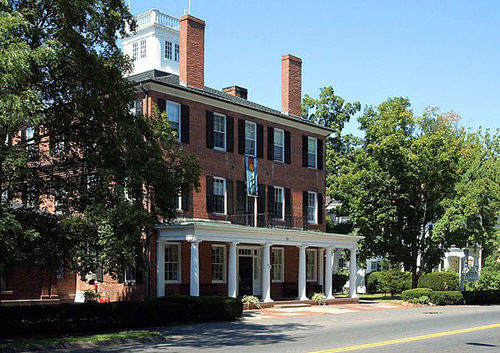
Zelda’s purview was the Penthouse Profile. Playboy had their famous Interview; because Penthouse had to be almost but not quite like Playboy, instead of Q&As we published celebrity profiles, which ranged from Marty Feldman to L. Ron Hubbard to the Ayatollah Khomeini to Robert Redford, whomever a writer could lasso into the magazine.
She was rail-thin, with big eyes and a doll face and an uncanny effect on guys: they wanted to protect Zelda from all the other rapacious men while ravishing her themselves. The only man I knew who was immune to her charms was my own boyfriend, Michael, who said to me those words every woman longs to hear: “She’s too skinny.”
Zelda merely had to waft by for VerMeulen to be smitten.
“I know someone who knows Bob Fosse. He’d make a great Penthouse profile,” pitched VerMeulen, straining his neck for another glimpse of the Lorelei who had captured his heart.
I had my doubts whether the Penthouse reader would be interested in a Broadway choreographer, no matter how famous or heterosexual, but ignored all my misgivings and wrangled a meeting for VerMeulen with Zelda.
Even though Zelda turned down his profile idea, VerMeulen came back to my little editorial pit with gaga hearts throbbing in his eyes. “I’m leaving my wife. I’m in love with Zelda,” he announced, as seriously as if he were discussing his next meal.
I marched VerMeulen over to the closest bar, P.J. Clarke’s, bought him a large drink, and gave him an earful of the Legends of Zelda, apocryphal gossip that we swapped gleefully about the Penthouse office. It was like a risqué game of Telephone; by the time a salacious Zelda story came back to me, the details were even more outlandish.
Among Zelda’s alleged suitors were:
- A Mafia capo, who enjoyed hanging her by the wrists and stubbing cigarettes out on her body.
- A European diplomat who bought her a wardrobe of handmade Belgian shoes and got his kicks by removing one pair of thousand dollar flats from her long, narrow feet and lovingly replacing it with another.
- My personal favorite, a television executive, the famed producer of 1960s game shows featuring celebrity panels. According to legend, in order to talk to his beloved the TV executive insisted on dragging his wife’s Pekinese out for an unwanted walk every evening at nine so he could duck into a street corner phone booth until one steamy conversation with Zelda proved to be too much for his dicky heart.

None of this dowsed VerMeulen’s ardor; from then on I never allowed him back in the office, always claiming that I had already popped his check in the mail.
When pressed for the facts, Zelda always laughed off every racy rumor; I was tempted to push up the sleeve of her cashmere twin set and check for cigarette burns. She wasn’t unaware of her power over men, but she didn’t consciously turn it off and on; it was magic, a gift from her own good fairy.
I was gleefully tearing open a day’s offerings to the service editor — an underwater camera! A bottle of Bacardi rum! An electric wok from some PR company who was not doing its research! — when Zelda’s tiny head popped over the side of my slanted cubicle. I hoped Zelda wouldn’t lean on the partition as her ninety-five pounds was enough to topple it.
“Hi Gay. Are you busy?”
I had unwrapped all my goodies. “Ah, no, what’s going on?”
Zelda glanced behind her and then scooted in to stand by my desk; I couldn’t offer her a seat as there was barely room for my own chair amid my towers of consumer loot.
“I have a huge favor to ask you. You know I share an office with Annie.”
That would be Annie O’Hare, the associate editor and the other fake Penthouse Pet besides me on the Watkins Glen junket of disaster.
“Could you switch offices with me?” if by office Zelda meant the two flimsy fabric-covered boards precariously perched around my desk.
“I can’t take her anymore. Her papers are all over the whole office, she never throws anything away or even files it. She is on the phone from the minute she comes in. I have to hear every detail of the bars and parties she was at the night before seven times a day! When she’s not on the phone she’s complaining and when she’s not complaining she’s smoking. Actually she smokes and complains at the same time.”
If I had been a man, Zelda would have had me at “Could you?” But I was suspicious. Zelda had an office — with a door! — and her desk faced a window, a window with an uninspiring view of Midtown but still a window, with daylight and weather. How horrible must Annie be if Zelda were willing to move into my doorless, windowless hovel at the back of the secretarial pool?
“Let me think about it,” I said.
I consulted with my pal, Senior Editor Peter Bloch, to see how bad the Trojan was in this gift horse. He shrugged. “I adore Annie, she’s smart and funny, but I don’t have to share an office with her. She can be…difficult.”
Difficult was okay, considering that even squirreled away in my back cubicle I was within earshot of Annie’s daily tirades, screeds that reverberated around the office, curse words echoing through the hallways. I could put up with difficult.
And I was still the newbie, grateful that Penthouse had rescued my fired ass and bestowed on me the best job ever. I would have taken my chances with Squeaky Fromme as an officemate to stay in the good graces of the other editors.
Under cover of darkness (5:05 pm when everyone else was already at the bar), Zelda and I switched offices.
At ten the next morning I was hunched over page proofs, my back to the door of my new office, when I felt a displacement of air and caught a whiff of menthol cigarette smoke. I swiveled, unable to hide my guilty expression as I realized Zelda or I should have said something to Annie; I couldn’t have been a pleasant surprise.
“Hi Annie…Zelda asked me to switch offices…and I…she…”
Annie marched by me and added a cigarette to the twenty-three others crushed out in her ashtray.
“So…Gay…I’m such an awful person that Zelda couldn’t stand to be around me.”
“Nobody said you were awful,” I blurted out, leaving unsaid what adjectives had been used to describe Annie.
Annie rolled her eyes, lit a Newport, and grabbed her telephone. I picked up my red pen and tried to will myself invisible and/or deaf.
Reader, I married her.
Not quite. She did become my best friend.
Considering History: The Presidency and Impeachment of Andrew Johnson
This column by American studies professor Ben Railton explores the connections between America’s past and present.
One hundred fifty years ago, Andrew Johnson became the first president of the United States to be impeached.
In 1864, facing a stiff challenge to his reelection campaign from Democratic nominee (and former Union general) George McClellan, President Abraham Lincoln decided to replace his current vice president, Hannibal Hamlin, on the ticket with a Democrat, Tennessee Senator and military governor Andrew Johnson. This choice allowed Lincoln and Johnson to run under the banner of the newly created National Union Party, emphasizing opposition to the Confederacy across the nation (and especially in contested border states like Tennessee). It was a pragmatic and clever strategic move, and likely contributed greatly to Lincoln’s eventual easy victory over McClellan in November 1864.
Yet as early as inauguration day, March 4, 1865, there were indications that Lincoln’s practical decision might have also been a mistake. Johnson may have been drunk at the inauguration (he had been witnessed drinking heavily at a party the night before and asked Hannibal Hamlin for two additional drinks just before the inauguration began), and in any case delivered a rambling, belligerent speech that was hastily cut off when Hamlin swore him in as the new vice president. And this ominous opening foreshadowed what would become, after Lincoln’s tragic April 14th assassination, one of the most divisive and destructive presidencies in American history.
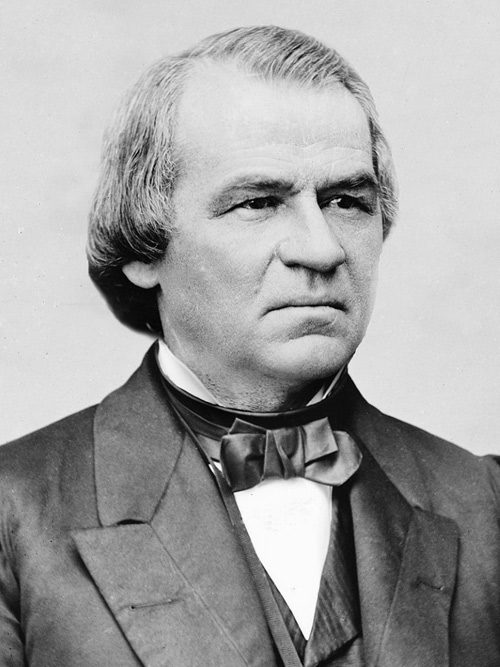
Johnson continued his pattern of belligerent and bellicose public statements as President. When supporters came to the White House in February 1866 for a Washington’s Birthday celebration, Johnson addressed them in another long, rambling speech, highlighting his own accomplishments more than 200 times and attacking “men still opposed to the Union” who were “as much laboring to pervert or destroy [fundamental American principles] as were the men who fought against us.” When pressed by audience members, he named Congressman Thaddeus Stevens and Senator Charles Sumner (among others) as these enemies. In August and September of that year he would embark on a national speaking tour unprecedented for a sitting president; known as the “Swing Around the Circle,” the tour featured more than twenty rallies in which Johnson continued to attack Congressional “enemies” and make the case for his divisive Presidential Reconstruction policies ahead of the November midterm elections.
Those extreme Presidential Reconstruction policies truly defined Johnson’s divisive and disastrous administration, both on their own terms and in contrast to what might have been the case had Lincoln not been killed. Although Johnson had been perceived as a moderate on issues of slavery and sectionalism prior to and during the Civil War, as president he revealed himself to be both a staunch ally of the neo-Confederate South and a virulent white supremacist. Among his earliest presidential proclamations, Johnson first recognized a provisional Virginia government that was practicing policies of forgiveness toward ex-Confederates and then provided federal amnesty for nearly all ex-rebels. He went on to support additional amnesty policies such as one that allowed ex-Confederates (such as former vice president of the Confederacy Alexander Stephens) to serve in Congress; since Johnson’s administration likewise opposed proposals for African American voting rights, nearly all of the Southerners elected to Congress in these early post-war years were former Confederates.
Johnson’s opposition to post-war rights for African Americans went far beyond opposing suffrage proposals. In February 1866 he vetoed a bill that would have extended the vital operations of the Freedmen’s Bureau beyond the agency’s scheduled 1867 abolition, claiming that the law “would not be consistent with the public welfare.” In March of the same year he vetoed the groundbreaking Civil Rights Bill, arguing in his veto message that “the distinction of race and color is by the bill made to operate in favor of the colored against the white race.” Johnson also opposed the 14th Amendment and campaigned extensively (if unsuccessfully) against its ratification by the states, solidifying his administration’s overall hostility to nearly all Reconstruction measures that focused on civil rights rather than reintegrating the Confederate South into the nation as smoothly as possible.
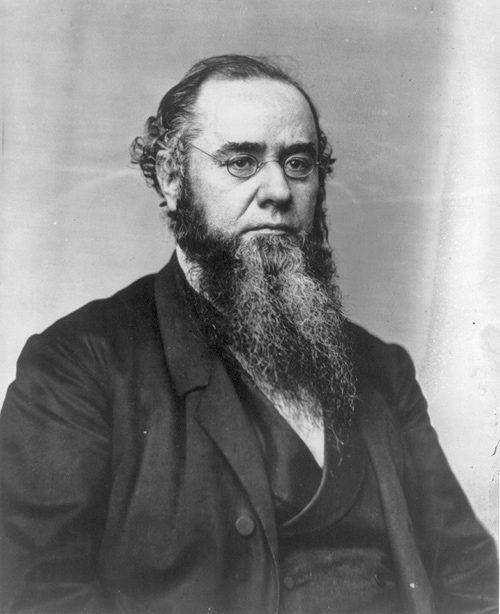
All those conflicts contributed to Johnson’s February 1868 impeachment by the House of Representatives, but it was his blatant, authoritarian violation of a specific law that directly precipitated the Congressional action. During his 1866 speaking tour, Johnson had pledged to fire Cabinet secretaries who did not agree with him (especially those who had been appointed under Lincoln), and in March 1867 he vetoed the Tenure of Office Act, which required Senate approval for such firings; Congress overrode his veto and passed the act into law. Throughout that year Johnson battled with Secretary of War Edwin Stanton, a Lincoln appointee and advocate of Congressional Reconstruction, harsher treatment of former Confederates, and African American rights. In August, with Congress out of session and unable to approve any Cabinet actions, Johnson demanded Stanton’s resignation; when Stanton refused, Johnson suspended him and replaced him with General of the Army Ulysses S. Grant. The conflict continued for many months, and when Johnson permanently dismissed Stanton in February 1868 without gaining Senate approval as required by law, the House of Representatives voted 128 to 47 to impeach.
After a three-month trial in the Senate, featuring so much wheeling and dealing that Johnson and his allies would later be investigated by Representative Benjamin Butler for bribery, the Senate on May 16, 1868, fell a single vote short of the two-thirds majority necessary to convict the president. Johnson would complete the remainder of his term, but as a deeply unpopular president; even his own Democratic Party denied him the 1868 presidential nomination in favor of former New York Governor Horatio Seymour (who would lose to the Republican nominee Ulysses S. Grant). On Christmas Day, 1868, Johnson took advantage of one of his last opportunities to further his neo-Confederate and white supremacist agendas, issuing a blanket amnesty that covered all former Confederates including the Confederate President Jefferson Davis.
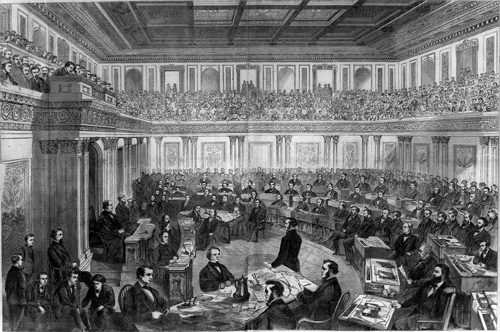
Johnson’s political career did not quite end with Grant’s election, as he made a successful run for a Tennessee Senate seat (at that time still decided by the state legislature) in early 1875. He would only serve for a few months before dying unexpectedly of a stroke in July, but during that time expressed his neo-Confederate views one last time (his only official remarks during his brief Senate term), criticizing Grant’s use of federal troops in Louisiana and asking, “How far off is military despotism?” One final belligerent and extreme remark from a president who remains one of the most divisive and destructive in American history.
10 Comics You Should Read Right Now
Read our article, Be Heroic! It’s International Read Comics in Public Day!
Comics aren’t just for ten-year-old boys anymore. Which comics should you be reading? There are thousands of series to choose from, so where’s a beginner to start?
That’s where I come in. I’m the resident comic book guy, and that’s because I’ve lived the entire cycle from fan to comics journalist to published pro comic book writer. This isn’t an exhaustive list by the stretch of anyone’s imagination, but it might provide some hints of where you might like to start. I don’t list every creative contributor to every volume mentioned, but that in no way diminishes the contributions of the writers, artists, letterers, colorists, and editors that work hard every day to entertain their readers.
1. If You Like Marvel Movies
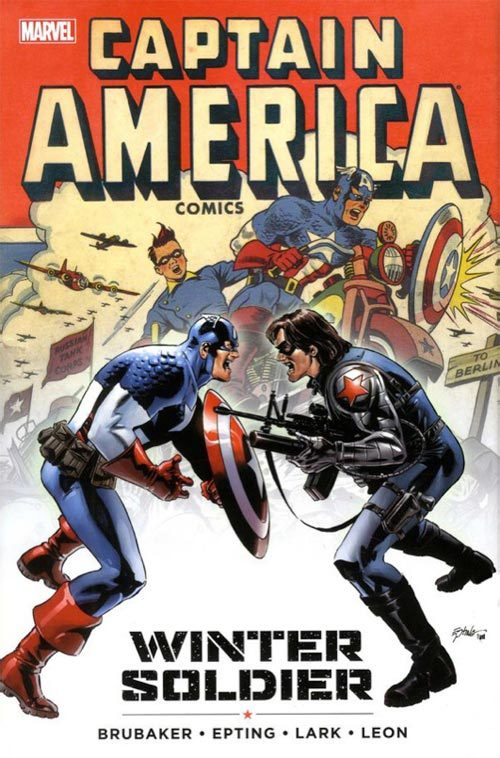
You might have 10 years of the Marvel Cinematic Universe, but you’ve got about 79 years of Marvel comics. A few gems that might pique the interest of the Marvel moviegoer include Captain America: The Winter Soldier by Ed Brubaker and Steve Epting, the Hawkeye solo series by Matt Fraction and David Aja, any Thor book written by Jason Aaron, the various volumes of Guardians of the Galaxy written by Dan Abnett and Andy Lanning, Black Panther: A Nation Under Our Feet by Ta-Nehisi Coates and Brian Stelfreeze, and the original Infinity Gauntlet by Jim Starlin, George Perez, and Ron Lim.
2. If You Like the Justice League
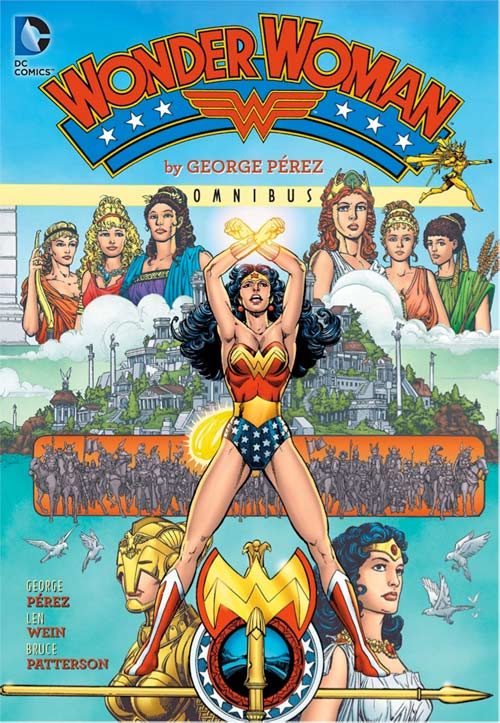
So you grew up with the Super Friends or Justice League on TV and you love the Big Guns of the DC Universe. You’re in luck: You have some of the most acclaimed comics ever ahead of you. Check out 1986’s The Dark Knight Returns by Frank Miller and Klaus Janson, which set the stage for the Batman of the movies. Grant Morrison and Frank Quitely’s All-Star Superman captures the essence of the Man of Steel. The various volumes of Wonder Woman by George Perez give you some classic Diana stories. And Grant Morrison’s masterful run on JLA with Howard Porter and others redefined the group for the modern audience.
3. If You Like Biographies/Autobiographies
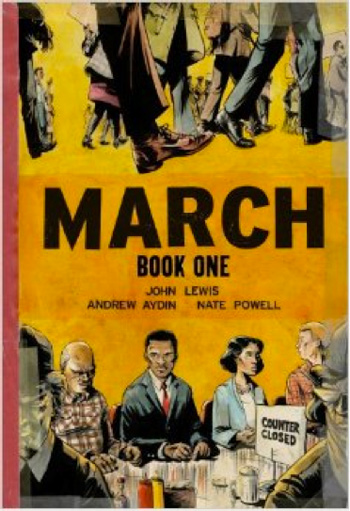
Comics are not just super-heroes. Super-heroes are the “cop show” of comics; there are a lot of them out in there in a lot of flavors, but they aren’t the only thing to watch. In fact, a number of incredible biographies exist in comic form. One of those is The Fifth Beatle: The Brian Epstein Story by Vivek J. Tiwary, Andrew C. Robinson, and Kyle Baker; it tells the story of the Fab Four’s visionary but doomed manager. A towering achievement in comics bio (and autobio) is Top Shelf’s March trilogy by John Lewis, Andrew Aydin and Nate Powell. The John Lewis in question is indeed the legendary congressman that fought for civil rights, and his story is rendered wonderfully by the sublime art of Powell. One more I can’t pass up is Fun Home: A Family Tragicomic by Alison Bechdel (also known as creator of the Bechdel test). With unflinching honesty, Bechdel deals with family secrets, including her own. And there’s also Marjane Satrapi’s Persepolis and Craig Thompson’s Blankets and Art Spiegelman’s Maus . . . okay, time to move on.
4. If You Like The Lord Of The Rings, But Wish It Were Funnier
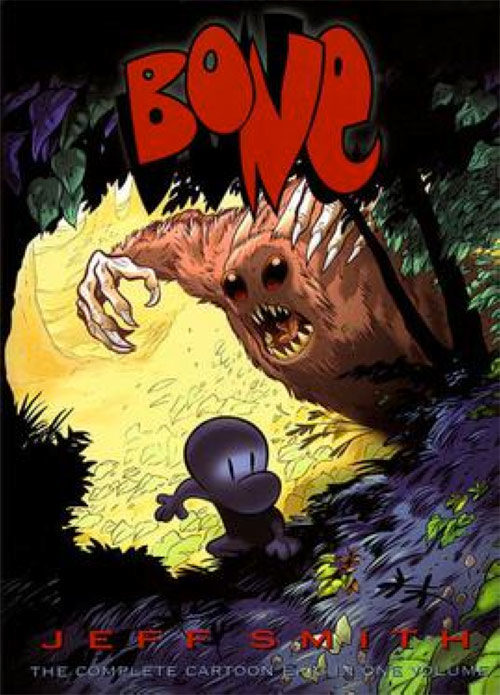
Believe me, there’s a metric ton of awesome fantasy comics out there, but I keep coming back to Bone. Jeff Smith’s magnum opus is available in one complete volume. In it, three cousins that look like funny comic strip characters stumble in a high fantasy valley on the verge of war. Becoming embroiled in events both hilarious (The Great Cow Race) and terrifying (the Lord of the Locusts may haunt your dreams), the cousins try to help their new friends while searching for a way back home. A sheer delight from cover to cover, Bone has won 10 Eisner Awards and is beloved around the world. Don’t miss it.
5. If You Like Teenage Heroes
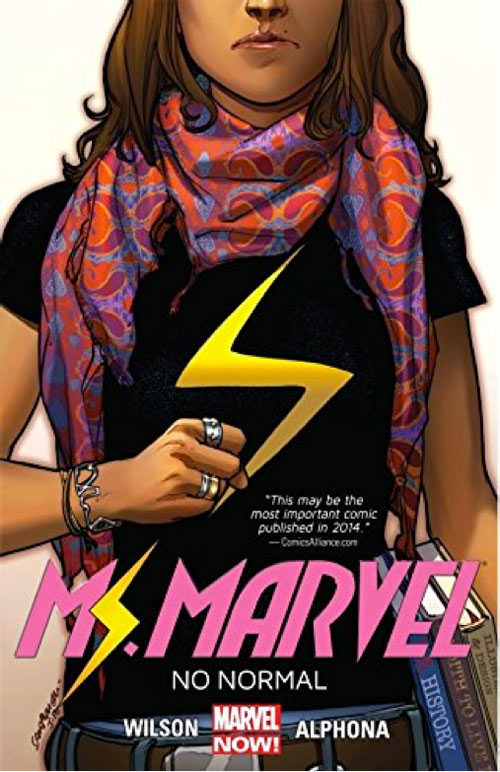
While there’s no shortage of teen heroes in comics, I’m going to focus a little bit on the Big Two of Marvel and DC. In recent years, Marvel’s had a bit of a teen hero renaissance with G. Willow Wilson’s Ms. Marvel at the forefront. Ms. Marvel is Kamala Khan, a Muslim Pakistani-American teen with shapeshifting powers and an encyclopedic knowledge of super-heroes. Though only introduced five years ago, Kamala has made her way into animation, action figures, and the comic book ranks of The Avengers. She’s also a member of teen team The Champions, which gathers a number of Marvel’s youth movement in one book. Kamala also shares the Marvel Rising animated series with The Unbeatable Squirrel Girl, a ridiculous-heroine with a thoroughly hilarious series (for you Netflix fans, she’s Luke Cage and Jessica Jones’s babysitter).
On the DC side, the terrific Super Sons books follow Superboy (Jonathan Kent, son of Clark and Lois) and Robin (Damian Wayne, son of Bruce and his enemy Talia ah Ghul). As written by Peter J. Tomasi, every issue contains at least one laugh-out-loud moment centering on the grudging friendship between the relentlessly upbeat Superboy and the comically dour Robin. Robin is also featured in DC’s young hero hang-out, Teen Titans.
6. If You Like Mysteries
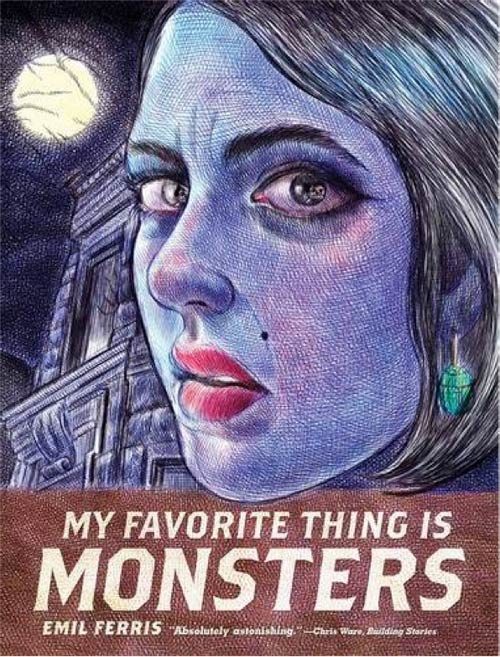
There are enough mystery series and original graph novels in comics for lit sites to run features on the top 10, or 25, or 50 mystery comics. I’ll hat-tip three. Torso, published at Image Comics by Brian Michael Bendis and Mark Andreyko, is a fictionalized account of the true story of the hunt of the Cleveland Torso Murderer of the 1930s by legendary lawman Eliot Ness. Batman: The Long Halloween by Jeph Loeb and Tim Sale gives us an early case from Batman’s career as he hunts a holiday-themed serial killer for a calendar year. The last one, My Favorite Thing is Monsters, published by Fantagraphics, has a story behind it that’s almost more remarkable than the book itself. After suffering from paralysis brought on by West Nile virus, writer and artist Emil Ferris fought her way back to recovery while working on her 700-page mystery. It won three Eisner Awards last year and is widely considered the best graphic novel of 2017.
7. If You Like Shakespeare, Gothic Culture, and General Amazement:
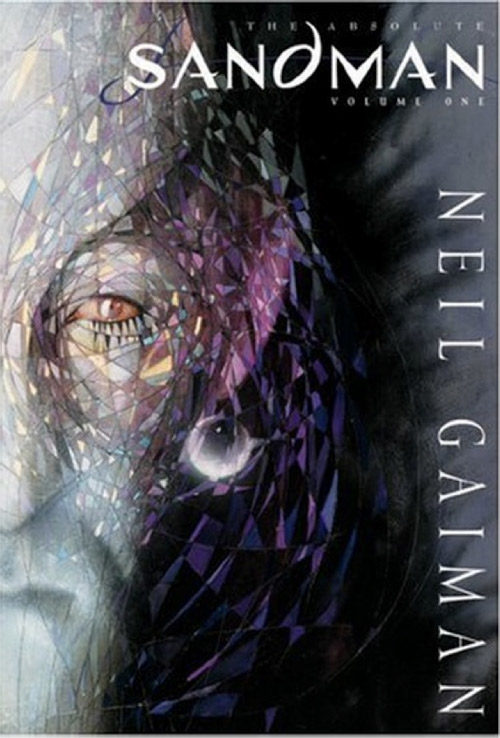
The Sandman series, by writer Neil Gaiman and a murderer’s row of incredibly talents artists, remains one of the great achievements in comics. After a period of captivity, Morpheus, the king of dreams, tries to reunite with his fractured family, including his loveable sister Death. A high point in fantasy, the series defied conventions and came to stand for “literary comics” in the best possible sense. Gaiman, of course, has continued to produce stellar works in comics, prose, and other media (American Gods, anyone?).
8. If You’re Anywhere from K-12

If you don’t know Raina Telgemeier, your kids or grandkids do. A one-woman brand that means great, heartfelt comics, Telgemeier built up a solid resume of work before breaking out with the autobiographical Smile in 2010; it stayed on The New York Times bestseller list for more than 220 weeks. Each subsequent release (Drama, Sisters, and Ghosts) has only expanded her popularity and demonstrated her unique sensitivity to the real issues affecting young people. To borrow another publishing phrase, she’s a wonder.
9. If You Like It Deconstructed
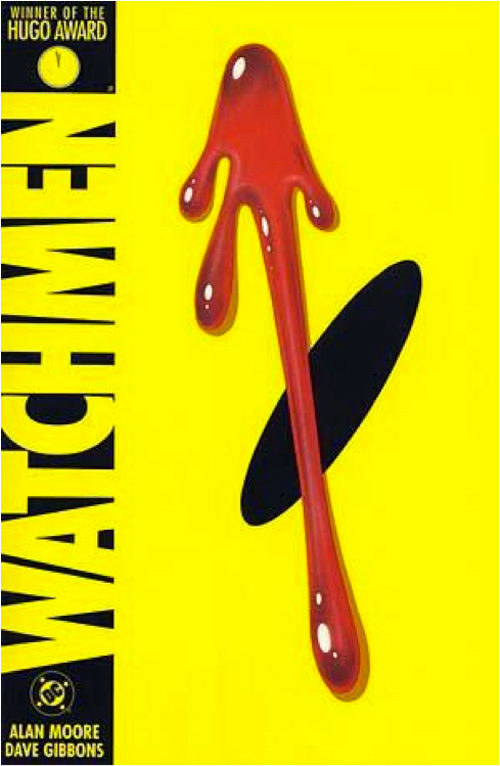
Alan Moore got big in super-hero comics, then he wanted to burn it all down. Seen by many as the author laureate of the comics form, Moore rebuilt DC’s Swamp Thing into a work of post-modern horror before turning his attention to the entire super-hero genre. Watchmen, with Dave Gibbons, remains a perennial bestseller and one of the things that pushed super-stories into the darkness in 1986. Since then, his vast repertoire of books like V for Vendetta, From Hell, The League of Extraordinary Gentlemen, and more continue to showcase his stunning attention to detail and his mastery of a medium that he keeps pushing toward maturity.
10. If You Like to Be Scared
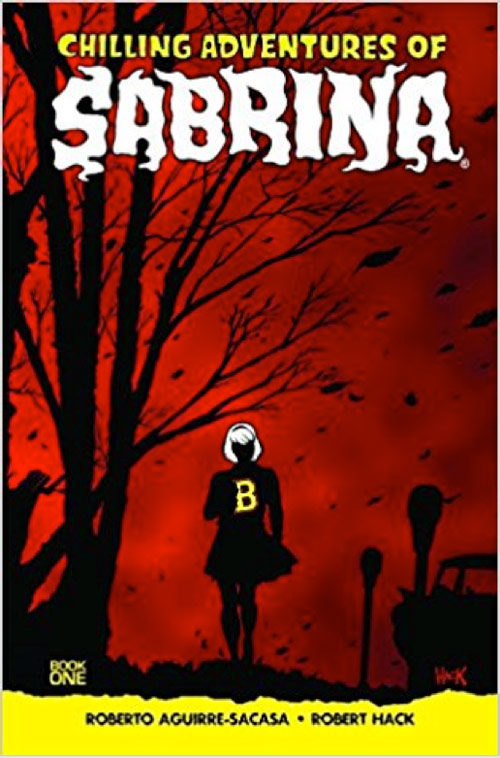
Well, you’re in luck. Horror abounds in comics. Easily the bestselling horror series of the last decade is The Walking Dead, basis for the TV show with a massive fanbase; if you follow Rick, Michonne, and Negan, it all started here. I also heartily endorse Uzumaki by Japanese horror manga legend Junji Ito; a masterwork of paranoia and Cronenbergian “body horror,” it’s an incredible unsettling read. And if you’re wondering why I haven’t mentioned Archie yet, that’s because I’ve been saving it. In the past few years, Archie Comics have totally reinvented themselves with a variety of series that take the characters into startling new directions. Two of the best are the horror titles Afterlife with Archie and Chilling Adventures of Sabrina, both written by Archie Comics Chief Creative Officer Roberto Aguirre-Sacasa (who also developed, executive produces, and writes for the Archie-derived TV series Riverdale).
Get out to your own local comic shop (or local library; graphic novel sections are huge there) and find what you like. And feel free to make your own recommendations in the comments below!
Be Heroic! It’s International Read Comics in Public Day!
Read our article, 10 Comics You Should Read in Public Right Now.
Comic book movies rule the world. Comic books, on the other hand, still carry a bit of social stigma that was already old in the 1950s. In 2010, Brian Heater and Sarah Morean of the now-defunct alternative comics site Daily Cross Hatch came up with the idea of International Read Comics in Public Day. Their plan was to promote comics and shake off any embarrassment that one might feel by reading comics in public by turning it around and celebrating the act. The chosen date, August 28th, is also the birthday of The King, Jack Kirby.
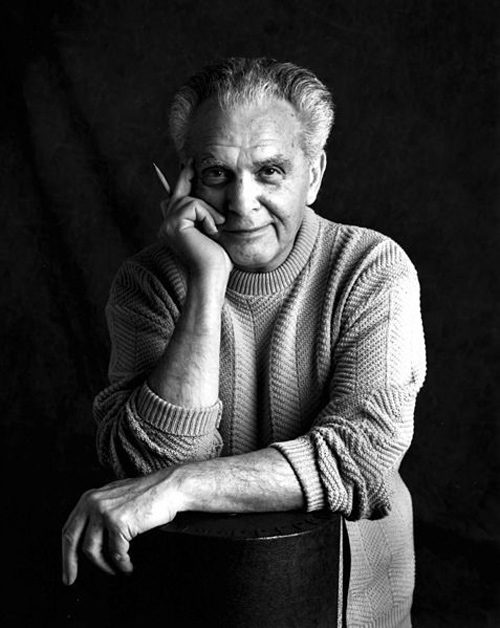
For those unaware, Kirby’s birthday might be the most appropriate day possible. Born in New York in 1917, Kirby grew up to be a working comic artist by 1936. Collaborating with Joe Simon in the 1940s, he co-created Captain America. With Stan Lee, he co-created the foundation of the Marvel Universe, including the Fantastic Four, Iron Man, Thor, the Hulk, the Avengers, the X-Men, Doctor Doom, the Inhumans, the Silver Surfer, Black Panther, and dozens more. Kirby would later work for DC Comics in the 1970s, where he created familiar characters like Darkseid, Mister Miracle, the New Gods, Kamandi, and The Demon, Etrigan. His mind-bending designs and panel-breaking art style seemed to erupt through the page, influencing generations of artists and filmmakers that followed in his wake. Nicknamed “The King” by Lee, Kirby worked in comics, animation and film, including a number of creator-owned projects, until his death in 1994.
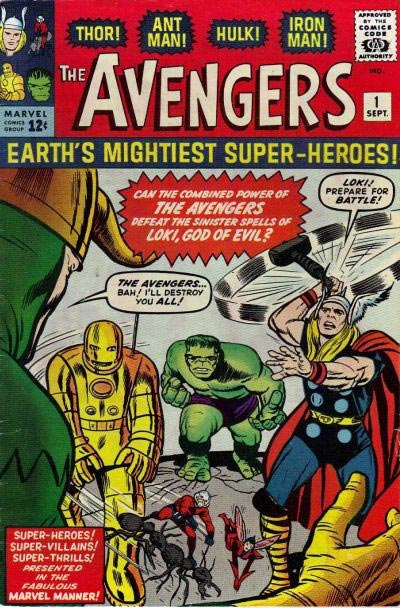
Kirby and Lee’s Marvel work helped repopularize comics in the 1960s, with Lee undertaking many speaking tours and appearances to evangelize for the form. Readership hit massive sales highs in the late ’80s and early ’90s before a speculator bust (caused when a number of new publishers and big events from established publishers saturated the market, allowing collectors little to no return on investment) crashed the back-issue market. Since then, comics have retrenched and conquered popular culture through mass media. Though comic-based films like 1978’s Superman The Movie would occasionally appear, the modern age of comic-based films didn’t begin in earnest until Blade staked out more mature territory in 1998. Today, super-heroes rule the box office, run rampant on television and streaming services, and have significant presence in the toy, video game, and apparel sections of mainstream stores. The comics form itself continues to thrive, having battled for acceptance (and frequently winning) in libraries, school curricula, and booksellers outside the comic shop. As Harvey Pekar, creator of American Splendor, once noted, “Comics are words and pictures. You can do anything with words and pictures.”

Current comic book professionals regard Read Comics in Public Day as an important yearly event. Jamal Igle, creator of Molly Danger and co-creator of the upcoming series, The Wrong Earth, says, “When I was a kid, I had a Spanish teacher who said ‘It doesn’t matter what you read, as long as you’re reading.’ It’s something I like to keep in mind as a creator and as a father. Reading comics in public day is a great way to encourage literacy in general. Selfishly, it’s also great to remind parents that comic books still exist, and are an excellent tool to get reluctant readers into the fold.”
If you’re curious if there’s a comic out there for you, the short answer is YES. Comics aren’t just bound to the super-hero genre. There’s horror, mystery, biography, comedy, and more, with as many books for mature readers as there are for young ones. You’re not bound by print, either, as you can buy digital comics from the likes of digital shop Comixology and find many independent webcomics online. A good pair of places to start is the Comic Shop Locator Service, which will lead you to a store near you, and the site for the Will Eisner Comic Industry Awards, aka The Eisners (basically the Oscars of comics), which contains a list of all the past winners so that you can start with the best. So get out, enjoy your day, and don’t forget the comics.
Five Things You Didn’t Know About the “I Have a Dream” Speech
Few words echo through history with the conviction and power of the “I Have a Dream” speech, given by Martin Luther King, Jr. 55 years ago today. Frequently ranked as the top speech in American history by polls and scholars, the address served as the defining moment of the March on Washington for Jobs and Freedom. King and other organizers mounted the march in support of civil rights legislation initiated by President John F. Kennedy. All of that could be considered common knowledge; here are a few things that you might not know about the speech and the events surrounding it.
The Speech.
1. It Wasn’t King’s First “Dream” Speech
When you look back at Dr. King’s oratorical history, it’s obvious that he liked to use dream allusions and imagery. It’s not difficult to understand why, as the civil rights struggle is essentially a dream of equality. King used that theme in a speech he gave to the NAACP in 1960 called “The Negro and The American Dream” in which he called America “a dream yet unfulfilled.” The speech emphasized that contributions that black Americans had already made and could continue to make and decried institutional racism, noting, “The primary reason for uprooting racial discrimination from our society is that it is morally wrong. It is a cancerous disease that prevents us from realizing the sublime principles of our Judeo-Christian tradition. It relegates persons to the status of things.” King would use the “dream” concept in further speeches in North Carolina in 1962 and Detroit in 1963, among other occasions.
2. The Speech Caught the Attention of the FBI
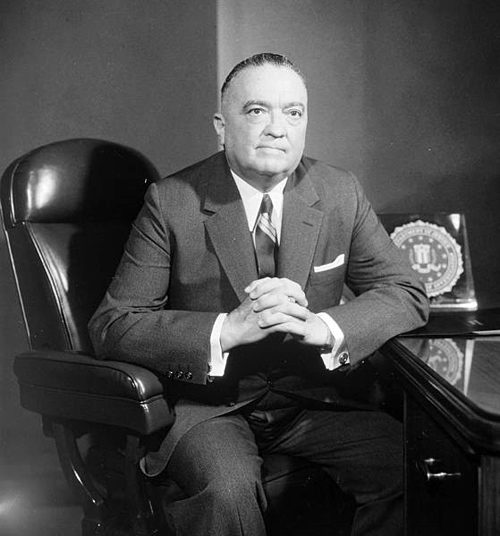
From 1956 to 1971, the FBI ran a series of operations that sought to dismantle domestic political groups. The umbrella name was COINTELPRO, which was derived from Counter Intelligence Program. Although the projects began by targeting the Communist Party in the United States, they expanded widely and involved infiltration, harassment, and, at times, violence directed against groups as diverse as the civil rights movement, feminist organizers, the Black Panther Party, the KKK, Puerto Rican independence activists, and more. King himself was a specific and frequent target of investigations and wiretaps as some people inside the Bureau viewed him as subversive. In Tim Weiner’s 2012 book, Enemies: A History of the FBI, Weiner offers a quote from FBI director J. Edgar Hoover in the wake of the “Dream” speech in which he says, “We must mark [King] now if we have not done so before, as the most dangerous Negro of the future in this nation from the standpoint of communism, the Negro, and national security.” The operation was overtly halted in 1971 after it was exposed by the activist group the Citizens’ Commission to Investigate the FBI.
3. It Made History in 17 Minutes
The speech itself took King 17 minutes to deliver. It has an official count of 1,667 words. That’s just over six times longer than Lincoln’s “Gettysburg Address,” which is widely considered King’s model for “I Have A Dream.”

4. The Speech Had Other Unshakable Lincoln Connections
The opening of the “I Have A Dream” speech includes the words “Five score years ago,” followed by a direct reference to the signing of the Emancipation Proclamation, the document that freed all the enslaved people in the south. Slavery officially ended in the United States with the passage of the Thirteenth Amendment in 1865. Of course, the speech was delivered at the incredibly appropriate location of the steps of the Lincoln Memorial. Today, a marble marker on the steps memorializes the occasion.
5. The Speech Immediately Changed King’s Life
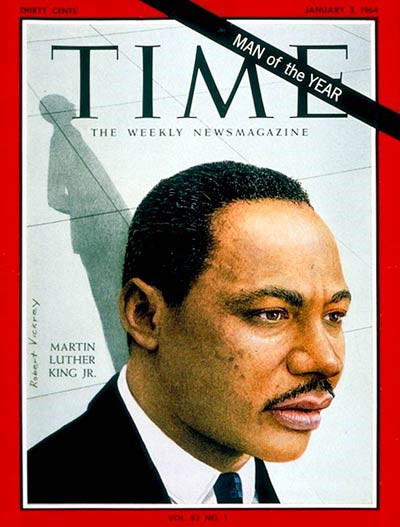
Scholars, journalists, and politicians have long discussed what the speech meant for the overall civil rights movement and what it continues to mean to people today. The immediate aftereffect for King is that it launched him into the stratosphere of political leadership in America. Not that he hadn’t already made an enormous reputation for himself, but in the time that followed, King became Time’s Man of the Year for 1963 and the youngest person awarded the Nobel Peace Prize in 1964. Though his life was unfortunately ended less than five years after delivering the speech, his legacy has proven immortal. The man is gone, but his dream lives.
Your Weekly Checkup: Chocolate Is Good for You
“Your Weekly Checkup” is our online column by Dr. Douglas Zipes, an internationally acclaimed cardiologist, professor, author, inventor, and authority on pacing and electrophysiology. Dr. Zipes is also a contributor to The Saturday Evening Post print magazine. Subscribe to receive thoughtful articles, new fiction, health and wellness advice, and gems from our archive.
Order Dr. Zipes’ new book, Damn the Naysayers: A Doctor’s Memoir.
It’s nice to know that some foods that taste good, such as coffee, wine, and the Mediterranean diet can also be good for you. Multiple studies indicate that chocolate falls into this category.
Dark chocolate in particular has been shown to reduce blood pressure, inflammation, and the amount of bad cholesterol (LDL) in the blood, and improve insulin effectiveness and blood vessel health. Chocolate consumption has also been linked to a decrease in heart failure, diabetes, atrial fibrillation, strokes and heart attacks.
The process of manufacturing dark chocolate retains a chemical compound called epicatechin thought responsible for the major health benefits of chocolate, whereas milk chocolate does not contain significant amounts of epicatechin.
Several studies suggest that dark chocolate from flavanol-rich cacao beans may enhance blood flow to central and peripheral nervous systems, improve cardiovascular function, and retard memory loss and other signs and symptoms of degenerative diseases, including Alzheimer’s and Parkinson’s diseases. The cacao flavanols in dark chocolate have antioxidant effects that retard and partially reverse degenerative changes in various diseases. Dark chocolate consumption also has been associated with enhanced mood and cognition. A recent study of 30 adults tested the impact of dark versus milk chocolate on vision. They noted small enhancements in visual acuity and large-letter contrast sensitivity and a slightly larger improvement in small-letter contrast sensitivity after consumption of dark compared with milk chocolate.
Not all studies on chocolate have been positive. Some negative outcomes might be expected because chocolate contain sugar, caffeine, and calories so that higher amounts of intake might be harmful. That raises the question of whether there might be a dose response association between chocolate intake and cardiovascular outcomes. That is, might there be an optimal protective dose of chocolate that decreases the risk of cardiovascular disease, with lower amounts having no effect and higher amounts causing harm?
A recent study addressed that question by reviewing and compiling information from fourteen reports on over 400,000 participants. The authors found an overall relative risk reduction of total strokes and heart attacks with chocolate intake, the strongest reduction observed between about 45 g/week (a chocolate single or square per day or a chocolate snack bar per week) and 60–75 g/week. The protective effect for cardiovascular disease was lost when chocolate intake exceeded 100 g/week (two chocolate snack bars per week). One needs to accept these results cautiously because chocolate consumption was self-reported, the type of chocolate could not be identified (which may underestimate the protective effects of dark chocolate), and one can only conclude an association between chocolate consumption and cardiovascular disease, not necessarily causality.
So, enjoy your daily dark chocolate wafer that not only tastes good but is good for you.
Getting Up Close with Polar Bears — While We Still Can
“Hello, beautiful,” the guide says, in the gentlest tone, to the polar bear lumbering toward us. We’d been watching her feed on berry-laden bushes on the muddy shores of Hudson Bay for about 20 minutes before she noticed us and headed over to investigate her audience — a dozen people from all over the world standing awestruck in matching red Gore-Tex jackets.
“What’cha doing sweetie?” he tries again as the bear keeps coming, slowly, cautiously.
Our three guides have handfuls of rocks in their hands and rifles slung over their shoulders. But the weapon they use today and most days is sound. At about 40 yards, one of the guides bangs a rock against our metal buggy and the bear jumps back, startled. She veers right and saunters away, looking over her massive shoulder to give us a final backward glance.
“Polar bears are like grizzly bears on Valium, they’re just so calm most of the time. But that doesn’t mean they can’t have a bad day.”
“From a predictability perspective, polar bears are like grizzly bears on Valium, they’re just so calm most of the time,” says Andrew Derocher, a University of Alberta professor who has been studying the bears for 35 years. “But it doesn’t mean they can’t have a bad day or bad interaction or just change their behavior. And that’s always the unknown.”
The female we’d been watching is one of about 800 bears that come to the western shores of Hudson Bay when the sea ice melts around June and July. They pass the warmer months lounging around, conserving energy, and waiting for the ice to come back in November. When it does, the bears climb back on and spend the winter moving over the frozen bay and gorging on seals.
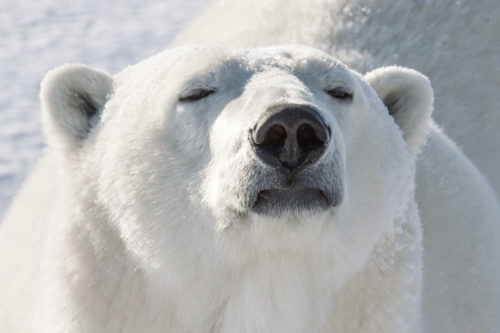
Thousands of tourists come to northern Manitoba every year to see the bears on the shoreline. The bear-watching industry started in the town of Churchill in the 1980s, when a few American journalists showed up and asked locals to drive them to the town dump to see what were then regarded as “giant white rats” scavenge in the garbage. After stories started appearing in glossy magazines, locals upped their game to accommodate the surge of tourists flocking to town. Today, one can take day trips in specially outfitted giant trucks called Tundra Buggies, or spend a week among the bears onboard a mobile hotel room, or fly into comfortable, remote lodges. The bears, meanwhile, have a new nickname: the poster children of climate change.
The bear population in Hudson Bay has been declining — as much as 18 percent from 2011 to 2016. “All indications are that Hudson Bay is not going to have polar bears in 20 or 30 years,” says Derocher. “There are so many things changing in the Arctic right now, it’s hard to predict how bears will respond. Going forward in time, changing sea ice, changing environmental conditions, competition — it’s not going to be the same as it has been in the past.”
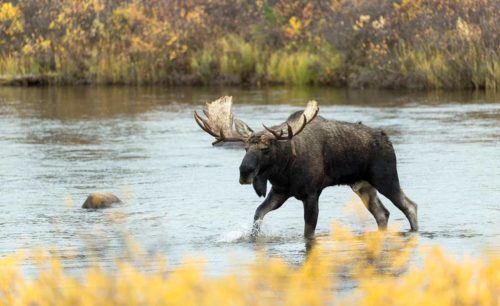
Getting There
It’s an hour-long flight from Churchill south to Churchill Wild’s Nanuk Polar Bear Lodge where we are staying, and along the way, we see a dozen or more bears lounging on the vast beaches below. Our pilot flies along the shoreline, pointing out the white blobs on the mud until we start spotting them ourselves. We land on a dirt strip on the other side of the lodge’s electric fence, where a few members of the local wolf pack sprawl out in the September sun. As our bags are unloaded, we see a black bear walk into the nearby brush. Business as usual in the wilds of Canada’s sub-Arctic.
Over the next few days, we put on our loaner red coats, pull mud-splattered blankets over our laps, and head out in open ATV buggies to look for bears, watch the wolves, and stand in the woods calling moose. Our Cree guide, Albert “Butch” Saunders, has been hunting, fishing, and trapping around Hudson Bay his entire life. He watches tracks to see where the moose might be, and when our buggies pull over, he pulls a string through a coffee canister, creating a wail that mimics the sound of a female moose. Another guide, Josh Robson, sways and dips in the long grass to impersonate a female moose. Eventually the song and dance works, and a massive bull moose emerges in the autumn mist. He doesn’t stick around long once he realizes the deception. Rather, there’s just Saunders with a big grin and a bunch of delighted people snapping pictures. Another day, as the buggies come over a crest of a hill, we see six moose running full out in the distance. More delight.

Back at the lodge, we watch wolf cubs frolic in the fall foliage through picture windows. Several scopes are set up for those who want a closer look. A week earlier, guides and guests watched through the scopes as a mama bear, her two cubs glued to her side, fended off a wolf pack. “It was terrible,” says guide Andy MacPherson of the 30-minute attack. “But I couldn’t look away.” Many wolves in this area starve to death, and taking down a polar bear would be a feast for the pack of 18. The wolves went for the bear’s neck, but she managed to fling them off and get away with her cubs. The day after we hear the tale of the fight, we see a beautiful black wolf with yellow eyes and gashes along its side. He’s in rough shape and lies down to rest under a tree, watching us watch him. I ask MacPherson which animals he was rooting for during the fight. He just shakes his head: “Nature chooses,” he says.
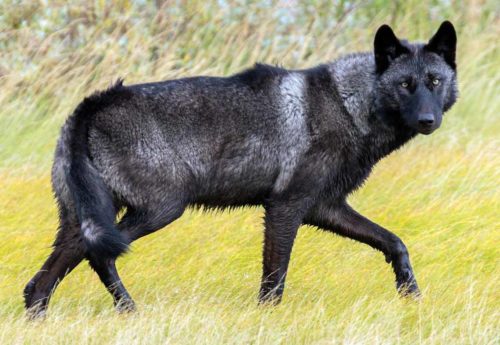
The Rules
When we’re outside the lodge’s electric fence, we have strict instructions: Be quiet. Stay close to the buggy. Do what you’re told. The guides use a careful system of deterrents to keep us and the bears safe. It starts with talking to the animals and progresses to startling them with clanging rocks or loud bangers. The rifles remain on the guides’ shoulders. “If I ever had to shoot a polar bear, I’d quit the business,” MacPherson tells me. He’s worked around bears for decades, studying how our behavior affects theirs. “Every time bears are seeing people, they’re learning, and they’re going to react differently in the future depending on what kind of interaction that was,” he says. “A negative interaction would be feeding animals — they’re going to come back. A positive interaction could be they come up and there’s no reward so you end up becoming part of the background.”
“All indications are that Hudson Bay is not going to have polar bears in 20 or 30 years.”
We climb into the buggies and travel about five miles to find a mother and her cub snuggling together on the mud. After about 20 minutes of watching them, the cub, curious, gets up and starts toward us. Mama dutifully follows. Guides MacPherson and Robson stand in front of us, rocks in hand. “Hey there, little guy — how’s it going?” MacPherson says. At the sound of his voice, the bears stop in their tracks. Eventually the cub, his fur gray with mud, gets bored of the sub-Arctic standoff and sits down. Mama bear stays up, lifting her snout to catch our scent 40 yards away. Meanwhile, Saunders stands with his broad back to all of us, scanning the horizon behind us with his binoculars.
“Time to go” MacPherson says, and we climb back in the buggies. As we drive off to the safety and comfort of the lodge, mama bear turns her head and watches us leave. I turn my head too, keeping my eyes on the polar bears as we get farther away and mother and cub turn into dots on the gray horizon, and then nothing at all.
Jennifer Allford is a freelance writer in Calgary, Canada. She writes a monthly lifestyle column in the Calgary Herald and has contributed travel stories to a number of publications, including the Toronto Star, WestJet Magazine, and Travel + Leisure. For more, visit jenniferallford.com.
This article is an expanded version of the interview that appears in the September/October 2018 issue of The Saturday Evening Post. Subscribe to the magazine for more art, inspiring stories, fiction, humor, and features from our archives.
May/June 2018 Limerick Laughs Winner and Runners-Up
So now we all know where he goes
When Santa seeks summer repose.
He trades in his sleigh
For artist’s beret
And paints with the grass ’neath his toes.
Congratulations to Michelle Gordon-Weedon of Airway Heights, Washington! For her limerick describing J.C. Leyendecker’s cover illustration for the May 26, 1934, issue of the Post, she wins $25 and our gratitude for a job well done.
If you’d like to enter the Limerick Laughs Contest for our upcoming issue, submit your limerick via our online entry form.
In no particular order, here are some of our other favorite entries to this limerick contest:
Said an elderly artist named Will,
“Painting nature is quite a big thrill.
The poses won’t last,
So I have to work fast
’Cause hummingbirds cannot sit still!”—Roger Blush, Irvine, California
My questions, I hope, won’t cause strife.
Is he ignoring the cute wildlife?
Is his nose red from drink?
And that sweater of pink …
Does it really belong to his wife?—Brian Federico, Clyde, New York
The animals witnessed that summer
A bearded and red-bereted plumber
Who sat at his easel
And painted a weasel
So perfectly — number by number.—Denis Feehan, Mesquite, Nevada
With butterflies, bluebird and doe,
Two bunnies complete our tableau.
Idyllic? You bet!
However, I get
Art critics wherever I go.—Steve Johnston, Peoria, Arizona
Well, this dwarf had the right to be mopey.
He again lost a film part to Dopey.
So he shed just one tear
As he cut off his ear.
You might know him: His name is Van-Gogh-pey.—Jennifer Klein, Jericho, New York
The painter applied his paint thick.
His brushwork was skillful and quick.
When the painting was done
He amazed everyone.
With a chuckle, he signed it “Saint Nick.”—Roy Skibiski, Lawndale, California
As the animals gather and stare,
He is sitting composed in his chair.
He is painting with ease
And enjoying the breeze,
But his painting is off by a hare.—Ryan Tilley, Altamonte Springs, Florida
As the animals gradually got bolder,
Painter’s temper had started to smolder.
He finally confided,
“I just can’t abide it —
You lot looking over my shoulder!”—Lisa Timpf, Simcoe, Ontario, Canada
For a masterpiece, Painter did strive.
The meadow, it seemed, came alive.
But the doe and the jay,
Concerned about pay,
Wanted time and a half after five.—Jon VanGutman, Olivehurst, California

